-
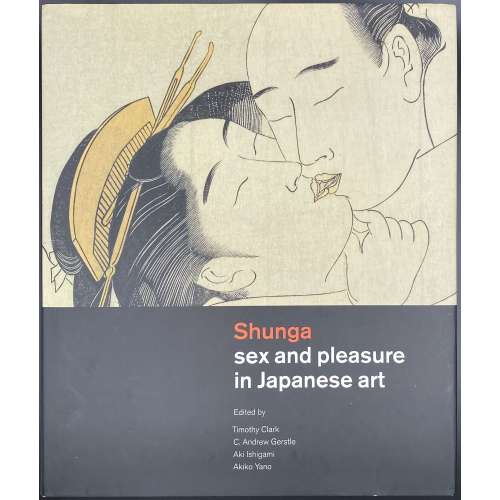 Hardcover volume, 29.6 x 25 x 4 cm, in red cloth with black lettering to spine, in pictorial dust jacket, profusely illustrated in colour; pp.: [1-6] 7-536, total 268 leaves and 2 folding plates extraneous to collation. Title-page: {Hotei's device} Hotei Publishing | Shunga | sex and pleasure in Japanese art | Edited by | Timothy Clark | C. Andrew Gerstle | Aki Ishigami | Akiki Yano || Contents: The Cultural Historical Significance and Importance of Japanese Shunga / Kobayashi Tadashi. Introduction: What Was Shunga? / C. Andrew Gerstle; Who Were the Audiences for Shunga? / Hayakawa Monta. (1) Early Shunga before 1765: Shunga Paintings before the `Floating World' / Akiko Yano; Chinese Chunhua and Japanese Shunga / Ishigami Aki; Shunga and the Rise of Print Culture / Asano Shugo. (2) Masterpieces of Shunga 1765-1850: The Essence of Ukiyo-e Shunga / Kobayashi Tadashi; Erotic Books as Luxury Goods / Ellis Tinios; Listening to the Voices in Shunga / Hayakawa Monta; The Tale of Genji in Shunga / Sato Satoru. (3) Censorship: Timeline of Censorship; Shunga and Censorship in the Edo Period (1600-1868) / Jennifer Preston; Graph of approximate output of shunga print series and books; The Censorship of Shunga in the Modern Era / Ishigami Aki; Shunga Studies in the Showa Era (1926-89) / Shirakura Yoshihiko. (4) Contexts for Shunga: Traditional Uses of Shunga / Yamamoto Yukari; The Distribution and Circulation of Erotic Prints and Books in the Edo Period Laura Moretti; Shunga and Parody / C. Andrew Gerstle; Popular Cults of Sex Organs in Japan / Suzuki Kenko; Grotesque Shunga / Ishigami Aki; Violence in Shunga / Higuchi Kazutaka; Foreign Connections in Shunga / Timon Screech; Children in Shunga / Akiko Yano; Shunga and the Floating World / Matsuba Ryoko. (5) Shunga in the Meiji Era: Erotic Art of the Meiji Era (1868-1912) / Rosina Buckland; The Modern West's Discovery of Shunga / Ricard Bru. Published to accompany the exhibition Shunga: sex and pleasure in Japanese art at the British Museum from 3 October 2013 to 5 January 2014. Abstract: This catalogue aims to answer some key questions about what is shunga and why it was produced. In particular, the social and cultural contexts for sex art in Japan are explored. Erotic Japanese art was heavily suppressed in Japan from the 1870s onwards as part of a process of cultural 'modernisation' that imported many contemporary western moral values. Only in the last twenty years or so has it been possible to publish unexpurgated examples in Japan and this landmark book places erotic Japanese art in its historical and cultural context for the first time. This book looks at painted and printed erotic images produced in Japan during the Edo period (1600-1868) and early Meiji era (1868-1912). These are related to the wider contexts of literature, theatre, the culture of the pleasure quarters, and urban consumerism; and interpreted in terms of their sensuality, reverence, humour and parody. Contributors: Timothy Clark (British, b. 1959) Timothy Clark (British, b. 1959) C. Andrew Gerstle (American, 1951) Aki Ishigami [石上阿希] (Japanese) Akiki Yano
Hardcover volume, 29.6 x 25 x 4 cm, in red cloth with black lettering to spine, in pictorial dust jacket, profusely illustrated in colour; pp.: [1-6] 7-536, total 268 leaves and 2 folding plates extraneous to collation. Title-page: {Hotei's device} Hotei Publishing | Shunga | sex and pleasure in Japanese art | Edited by | Timothy Clark | C. Andrew Gerstle | Aki Ishigami | Akiki Yano || Contents: The Cultural Historical Significance and Importance of Japanese Shunga / Kobayashi Tadashi. Introduction: What Was Shunga? / C. Andrew Gerstle; Who Were the Audiences for Shunga? / Hayakawa Monta. (1) Early Shunga before 1765: Shunga Paintings before the `Floating World' / Akiko Yano; Chinese Chunhua and Japanese Shunga / Ishigami Aki; Shunga and the Rise of Print Culture / Asano Shugo. (2) Masterpieces of Shunga 1765-1850: The Essence of Ukiyo-e Shunga / Kobayashi Tadashi; Erotic Books as Luxury Goods / Ellis Tinios; Listening to the Voices in Shunga / Hayakawa Monta; The Tale of Genji in Shunga / Sato Satoru. (3) Censorship: Timeline of Censorship; Shunga and Censorship in the Edo Period (1600-1868) / Jennifer Preston; Graph of approximate output of shunga print series and books; The Censorship of Shunga in the Modern Era / Ishigami Aki; Shunga Studies in the Showa Era (1926-89) / Shirakura Yoshihiko. (4) Contexts for Shunga: Traditional Uses of Shunga / Yamamoto Yukari; The Distribution and Circulation of Erotic Prints and Books in the Edo Period Laura Moretti; Shunga and Parody / C. Andrew Gerstle; Popular Cults of Sex Organs in Japan / Suzuki Kenko; Grotesque Shunga / Ishigami Aki; Violence in Shunga / Higuchi Kazutaka; Foreign Connections in Shunga / Timon Screech; Children in Shunga / Akiko Yano; Shunga and the Floating World / Matsuba Ryoko. (5) Shunga in the Meiji Era: Erotic Art of the Meiji Era (1868-1912) / Rosina Buckland; The Modern West's Discovery of Shunga / Ricard Bru. Published to accompany the exhibition Shunga: sex and pleasure in Japanese art at the British Museum from 3 October 2013 to 5 January 2014. Abstract: This catalogue aims to answer some key questions about what is shunga and why it was produced. In particular, the social and cultural contexts for sex art in Japan are explored. Erotic Japanese art was heavily suppressed in Japan from the 1870s onwards as part of a process of cultural 'modernisation' that imported many contemporary western moral values. Only in the last twenty years or so has it been possible to publish unexpurgated examples in Japan and this landmark book places erotic Japanese art in its historical and cultural context for the first time. This book looks at painted and printed erotic images produced in Japan during the Edo period (1600-1868) and early Meiji era (1868-1912). These are related to the wider contexts of literature, theatre, the culture of the pleasure quarters, and urban consumerism; and interpreted in terms of their sensuality, reverence, humour and parody. Contributors: Timothy Clark (British, b. 1959) Timothy Clark (British, b. 1959) C. Andrew Gerstle (American, 1951) Aki Ishigami [石上阿希] (Japanese) Akiki Yano -
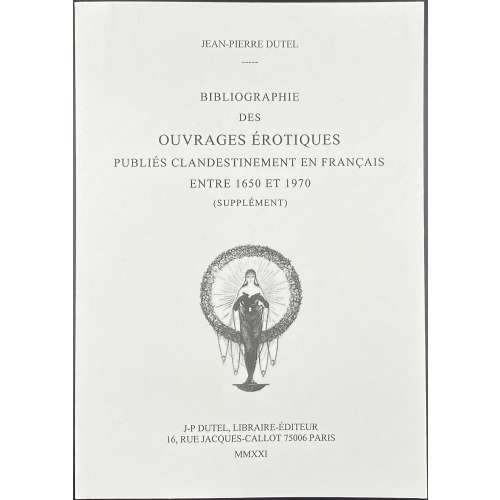 Description: Publisher’s wrappers 24 x 17 cm, pp. [1-6] 7-125 [3], total 64 leaves, edition limited to 150 copies. Includes “Errata & Addenda”, published in 2022. Cover and title-page: JEAN-PIERRE DUTEL | – | BIBLIOGRAPHIE | DES | OUVRAGES ÉROTIQUES | PUBLIÉS CLANDESTINEMENT EN FRANÇAIS | ENTRE 1650 ET 1970 (SUPPLÉMENT) | {publisher’s device} | J-P DUTEL, LIBRAIRE-ÉDITEUR | 16, RUE JACQUES-CALLOT 75006 PARIS | MMXXI ||
Description: Publisher’s wrappers 24 x 17 cm, pp. [1-6] 7-125 [3], total 64 leaves, edition limited to 150 copies. Includes “Errata & Addenda”, published in 2022. Cover and title-page: JEAN-PIERRE DUTEL | – | BIBLIOGRAPHIE | DES | OUVRAGES ÉROTIQUES | PUBLIÉS CLANDESTINEMENT EN FRANÇAIS | ENTRE 1650 ET 1970 (SUPPLÉMENT) | {publisher’s device} | J-P DUTEL, LIBRAIRE-ÉDITEUR | 16, RUE JACQUES-CALLOT 75006 PARIS | MMXXI || -
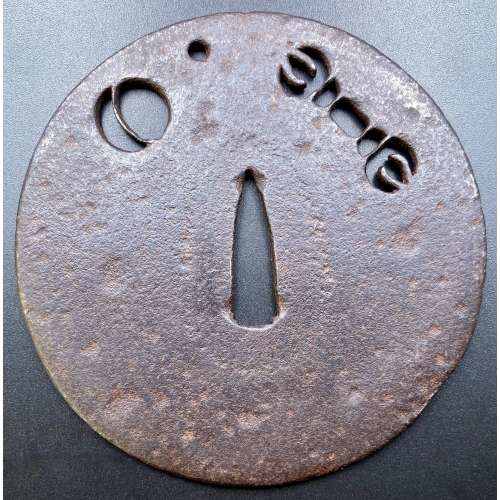 A ko-tosho tsuba made of iron, of the round form (丸型, maru-gata), pierced in negative silhouette (文透, mon-sukashi) with the design of Shingon Buddhism symbols of vajra [金剛杵] (kongosho), Sun, Moon and Star [月日星] (tsuki-hi-hoshi) – three sources of light [三光] (sankō). Round rim. No hitsu-ana; the shape of nakago-ana may suggest use on naginata [薙刀. Muromachi period (1393 – 1573). Height: 94.4 mm, Width: 93.4 mm, Centre thickness: 3.1 mm. Another possible explanation for "The element at the 11-o’clock position is in my opinion a kemari ball for the courtly game of the same name (picture attached)" [Markus Sesko].
A ko-tosho tsuba made of iron, of the round form (丸型, maru-gata), pierced in negative silhouette (文透, mon-sukashi) with the design of Shingon Buddhism symbols of vajra [金剛杵] (kongosho), Sun, Moon and Star [月日星] (tsuki-hi-hoshi) – three sources of light [三光] (sankō). Round rim. No hitsu-ana; the shape of nakago-ana may suggest use on naginata [薙刀. Muromachi period (1393 – 1573). Height: 94.4 mm, Width: 93.4 mm, Centre thickness: 3.1 mm. Another possible explanation for "The element at the 11-o’clock position is in my opinion a kemari ball for the courtly game of the same name (picture attached)" [Markus Sesko].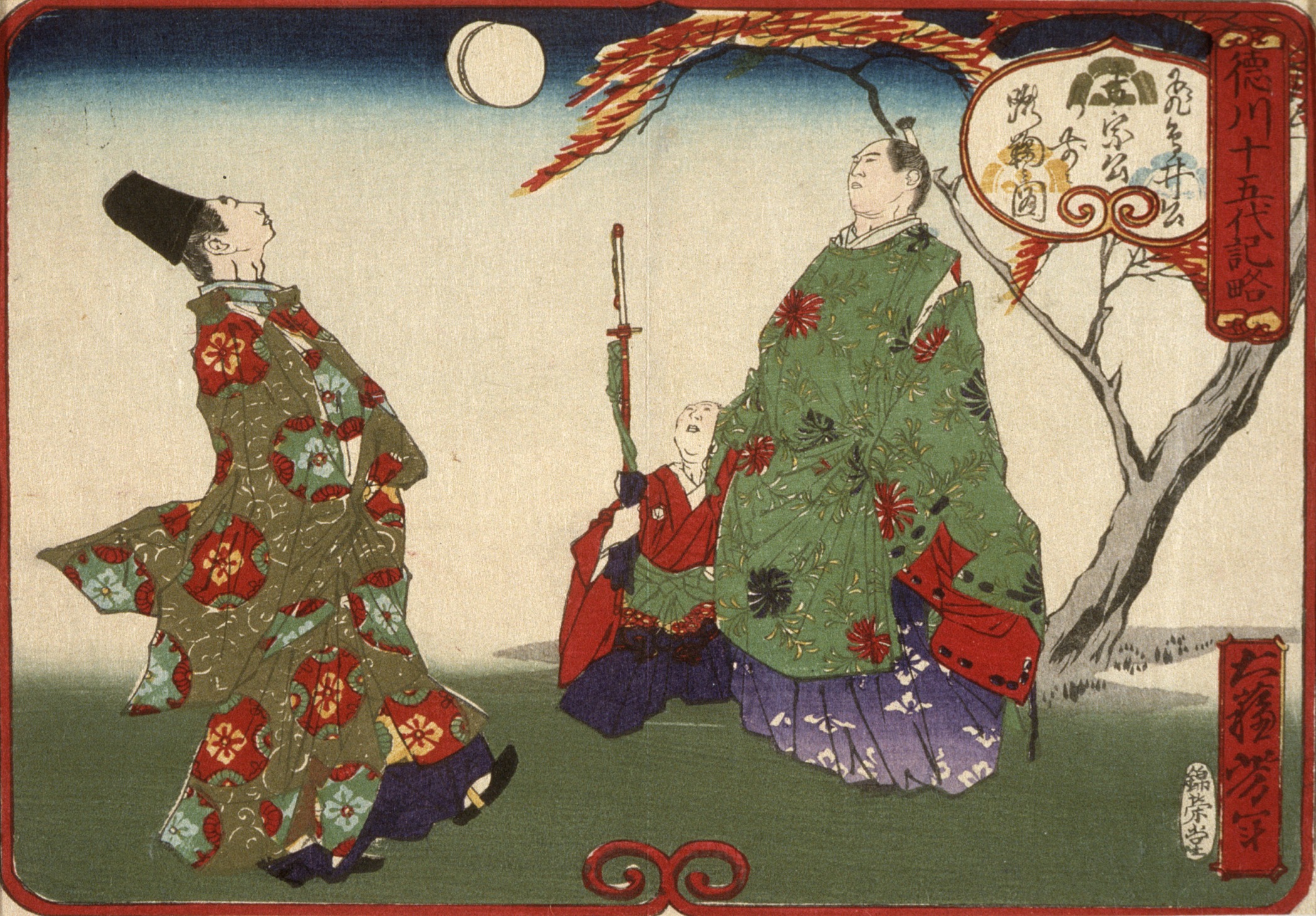
Tsukioka Yoshitoshi [月岡 芳年] (Japan, 1839 – 1892): Tokugawa Yoshimune [徳川 吉宗] (1684 – 1751) playing kemari [蹴鞠]
-
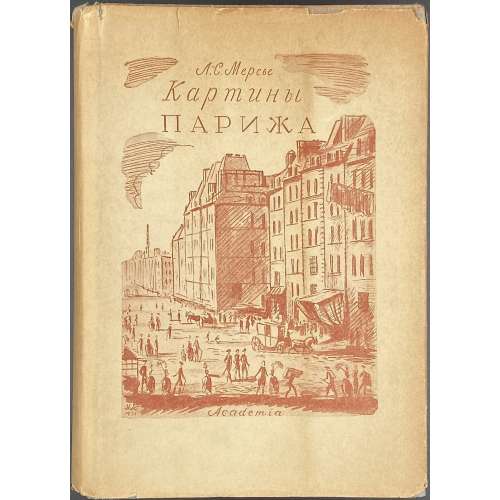 Russian translation of Louis-Sébastien Mercier. Tableau de Paris (1781). First edition, thus. Two volumes, 19.5 x 14 cm, uniformly bound in blue cloth with dark blue vignette to front cover and lettering to spine, in pictorial dust jacket; pp. vol. I: [I-VI] VII-LIII [LIV] [2] [2] 3-565 [566] [2]; collated 8vo: [I]-III8, IV4, [1]-358 364; total 312 leaves (624 pages) plus repro engraved frontispiece and 21 plates; vol 2: [1-10] 11-492 [4], collated 8vo: [1]-318; total 248 leaves (496 pages) plus 29 plates. Design by Н. В. Кузьмин. Title-page (black and red): ЛУИ-СЕБАСТЬЯН МЕРСЬЕ | КАРТИНЫ ПАРИЖА | Перевод В. А. Барбашевой | Редакция и комментарии | Е. А. Гунста | Статья Ц. Фридлянда | ТОМ ПЕРВЫЙ (ВТОРОЙ) | ACADEMIA | 1935(6) || Opposite t.p. (black and red): ФРАНЦУЗСКАЯ ЛИТЕРАТУРА | ЛУИ-СЕБАСТЬЯН МЕРСЬЕ | 1740—1814 | ACADEMIA | Москва—Ленинград || T.p. verso: LOUIS-SÉBASTIEN MERCIER | TABLEAU DE PARIS | 1781 | Супер-обложка и переплет | Н. В. Кузьмина || Print run: 5,300 copies. Catalogue raisonné: Крылов-Кичатова 747 (vol. 1), 838 (vol. 2). Contributors: Louis-Sébastien Mercier (French, 1740 – 1814) – author. Барбашева, Вера Александровна (Russian, 1875 – 1943) – translator. Гунст, Евгений Анатольевич (Russian, 1901 – 1983) – editor, comments. Фридлянд, Цви [Григорий Самойлович] (Russian-Jewish, 1897 – 1937) – author (preface). Kuzmin, Nikolai Vasilievich [Кузьмин, Николай Васильевич] (Russian, 1890 – 1987) – artist.
Russian translation of Louis-Sébastien Mercier. Tableau de Paris (1781). First edition, thus. Two volumes, 19.5 x 14 cm, uniformly bound in blue cloth with dark blue vignette to front cover and lettering to spine, in pictorial dust jacket; pp. vol. I: [I-VI] VII-LIII [LIV] [2] [2] 3-565 [566] [2]; collated 8vo: [I]-III8, IV4, [1]-358 364; total 312 leaves (624 pages) plus repro engraved frontispiece and 21 plates; vol 2: [1-10] 11-492 [4], collated 8vo: [1]-318; total 248 leaves (496 pages) plus 29 plates. Design by Н. В. Кузьмин. Title-page (black and red): ЛУИ-СЕБАСТЬЯН МЕРСЬЕ | КАРТИНЫ ПАРИЖА | Перевод В. А. Барбашевой | Редакция и комментарии | Е. А. Гунста | Статья Ц. Фридлянда | ТОМ ПЕРВЫЙ (ВТОРОЙ) | ACADEMIA | 1935(6) || Opposite t.p. (black and red): ФРАНЦУЗСКАЯ ЛИТЕРАТУРА | ЛУИ-СЕБАСТЬЯН МЕРСЬЕ | 1740—1814 | ACADEMIA | Москва—Ленинград || T.p. verso: LOUIS-SÉBASTIEN MERCIER | TABLEAU DE PARIS | 1781 | Супер-обложка и переплет | Н. В. Кузьмина || Print run: 5,300 copies. Catalogue raisonné: Крылов-Кичатова 747 (vol. 1), 838 (vol. 2). Contributors: Louis-Sébastien Mercier (French, 1740 – 1814) – author. Барбашева, Вера Александровна (Russian, 1875 – 1943) – translator. Гунст, Евгений Анатольевич (Russian, 1901 – 1983) – editor, comments. Фридлянд, Цви [Григорий Самойлович] (Russian-Jewish, 1897 – 1937) – author (preface). Kuzmin, Nikolai Vasilievich [Кузьмин, Николай Васильевич] (Russian, 1890 – 1987) – artist. -
 Artist: Utagawa Kunisada [歌川 国貞] a.k.a. Utagawa Toyokuni III [三代歌川豊国] (Japanese, 1786 – 1865). Pubisher (accorfding to Suzuki & Oka): Ibaya Senzaburō [伊場屋仙三郎] (Japanese, 1815 – 1869), Dansendō [伊場仙]. Title: Beauty holding a roll of paper (by seller); A woman of Edo (by Suzuki & Oka) Date seal and aratame censor seal: 1822 (Bunsei 5). Signed: Gototei Kunisada ga [五渡亭国貞画]. Media: Untrimmed fan print (uchiwa-e), 228 x 295 mm. Ref: [LIB-3085.2022] Jūzō Suzuki, Isaburō Oka. “The decadents”. — Tokyo: Kodansha International, 1969, p. 35, plate 30: exactly this print:
Artist: Utagawa Kunisada [歌川 国貞] a.k.a. Utagawa Toyokuni III [三代歌川豊国] (Japanese, 1786 – 1865). Pubisher (accorfding to Suzuki & Oka): Ibaya Senzaburō [伊場屋仙三郎] (Japanese, 1815 – 1869), Dansendō [伊場仙]. Title: Beauty holding a roll of paper (by seller); A woman of Edo (by Suzuki & Oka) Date seal and aratame censor seal: 1822 (Bunsei 5). Signed: Gototei Kunisada ga [五渡亭国貞画]. Media: Untrimmed fan print (uchiwa-e), 228 x 295 mm. Ref: [LIB-3085.2022] Jūzō Suzuki, Isaburō Oka. “The decadents”. — Tokyo: Kodansha International, 1969, p. 35, plate 30: exactly this print:
-
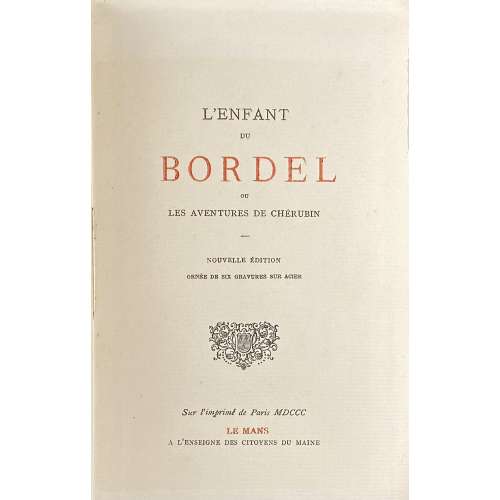 Softcover volume, 17.5 x 11 cm, in-12, brown wrappers without lettering, text printed on laid paper, six plates on India paper barbarously glued in, pp.: fep, [4] (h.t. t.p.), [1-3] 4-182, fep. Title-page (red and black): L’ENFANT | DU | BORDEL | OU | LES AVENTURES DE CHÉRUBIN | – | NOUVELLE ÉDITION | ORNÉE DE SIX GRAVURES SUR ACIER | {fleuron} | Sur l’imprimé de Paris MDCCC | LE MANS | A L’ENSEIGNE DES CITOYENS DU MAINE || Catalogue raisonné: Dutel I: A-325; Pia 395: 222 pages (we have 182 as per Dutel), attributes publication to Poulet-Malassis, 1866. Catalogue Poulet-Malassis & ses amis description: № 82.[PIGAULT-LEBRUN]. L’Enfant du Bordel, ou Les Aventures de Chérubin, nouvelle édition, ornée de six gravures sur acier. Sur l’imprimé de Paris, MDCCC, Le Mans, à l’enseigne des citoyens du Maine. [A. Christiaens, 1875 ?]. In-12, broché. 2 .n.ch., 182 pages, 1 f. blanc, couverture muette en papier vieux orange. Illustré de 6 figures hors-texte sur acier. Bibliographie : G* 553 (40 frs), Dutel A-325. Contributors: Guillaume Charles Antoine Pigault de l'Espinoy [Pigault-Lebrun] (French, 1753 – 1835) – author. Alexis Christiaens (Belgian, d. 1880) – publisher.
Softcover volume, 17.5 x 11 cm, in-12, brown wrappers without lettering, text printed on laid paper, six plates on India paper barbarously glued in, pp.: fep, [4] (h.t. t.p.), [1-3] 4-182, fep. Title-page (red and black): L’ENFANT | DU | BORDEL | OU | LES AVENTURES DE CHÉRUBIN | – | NOUVELLE ÉDITION | ORNÉE DE SIX GRAVURES SUR ACIER | {fleuron} | Sur l’imprimé de Paris MDCCC | LE MANS | A L’ENSEIGNE DES CITOYENS DU MAINE || Catalogue raisonné: Dutel I: A-325; Pia 395: 222 pages (we have 182 as per Dutel), attributes publication to Poulet-Malassis, 1866. Catalogue Poulet-Malassis & ses amis description: № 82.[PIGAULT-LEBRUN]. L’Enfant du Bordel, ou Les Aventures de Chérubin, nouvelle édition, ornée de six gravures sur acier. Sur l’imprimé de Paris, MDCCC, Le Mans, à l’enseigne des citoyens du Maine. [A. Christiaens, 1875 ?]. In-12, broché. 2 .n.ch., 182 pages, 1 f. blanc, couverture muette en papier vieux orange. Illustré de 6 figures hors-texte sur acier. Bibliographie : G* 553 (40 frs), Dutel A-325. Contributors: Guillaume Charles Antoine Pigault de l'Espinoy [Pigault-Lebrun] (French, 1753 – 1835) – author. Alexis Christiaens (Belgian, d. 1880) – publisher. -
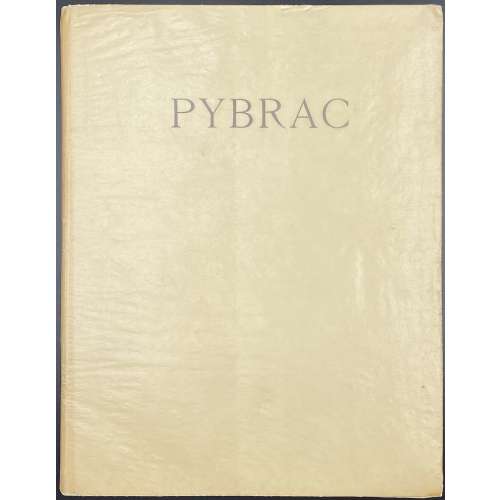 Description: One volume in French flapped cream wrappers, 25.5 x 19.5 cm, lettered “PYBRAC”, in glassine DJ, collated 4to, printed on watermarked Van Gelder laid paper, outer and bottom margins untrimmed, illustrated with 20 in-text drypoints on recto of each 1st and 3rd leaf of 1-10 gatherings, some with tipped-in tissue guards, unbound. This copy lacks the frontispiece, 10 full-page plates, and does not have any enrichment. It is one volume instead of two. Title-page: PYBRAC | ILLUSTRE DE TRENTE POINT SÈCHES | D’UN | ARTISTE INCONNU | PARIS | AUX DÉPENS D’UN AMATEUR | — | M. CM. XXVIII || Limitation: Edition limited to 30 copies, 1 copy unique on Japon Nacré with 30 original sketches, one suite in colour, two suites in black and 5 cancelled plates; 29 copies on Hollande Van Gelder, with one original watercolour, four original sketches, one suite in colour, two suites in black and 5 cancelled plates. This is copy № 8 (but without 11 full-page plates and with no enrichment). For a unique copy of the enriched edition in this collection, see LIB-3065.2022. Collation: π4 (2 blanks, h.t., t.p.), 1-104, χ2 (2 blanks), total 46 leaves. Pagination: [8] 1-78 [2] [4], total 92 pages. Catalogue raisonné: Dutel (1920-1970): № 2279, p. 334, Pia (Enfer):№ 1117, p. 586, Nordmann (I):№ 235; Vokaer № 23, p. 13; Fekete:№ 216. Contributors: Pierre Louÿs (French, 1870 – 1925) – author. Marcel Vertès [Marcell Vértes] (Jewish-Hungarian-French, 1895 – 1961) – artist.
Description: One volume in French flapped cream wrappers, 25.5 x 19.5 cm, lettered “PYBRAC”, in glassine DJ, collated 4to, printed on watermarked Van Gelder laid paper, outer and bottom margins untrimmed, illustrated with 20 in-text drypoints on recto of each 1st and 3rd leaf of 1-10 gatherings, some with tipped-in tissue guards, unbound. This copy lacks the frontispiece, 10 full-page plates, and does not have any enrichment. It is one volume instead of two. Title-page: PYBRAC | ILLUSTRE DE TRENTE POINT SÈCHES | D’UN | ARTISTE INCONNU | PARIS | AUX DÉPENS D’UN AMATEUR | — | M. CM. XXVIII || Limitation: Edition limited to 30 copies, 1 copy unique on Japon Nacré with 30 original sketches, one suite in colour, two suites in black and 5 cancelled plates; 29 copies on Hollande Van Gelder, with one original watercolour, four original sketches, one suite in colour, two suites in black and 5 cancelled plates. This is copy № 8 (but without 11 full-page plates and with no enrichment). For a unique copy of the enriched edition in this collection, see LIB-3065.2022. Collation: π4 (2 blanks, h.t., t.p.), 1-104, χ2 (2 blanks), total 46 leaves. Pagination: [8] 1-78 [2] [4], total 92 pages. Catalogue raisonné: Dutel (1920-1970): № 2279, p. 334, Pia (Enfer):№ 1117, p. 586, Nordmann (I):№ 235; Vokaer № 23, p. 13; Fekete:№ 216. Contributors: Pierre Louÿs (French, 1870 – 1925) – author. Marcel Vertès [Marcell Vértes] (Jewish-Hungarian-French, 1895 – 1961) – artist. -
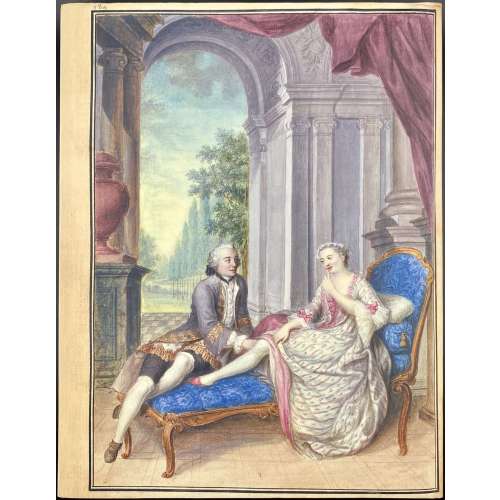 Description: One volume 32.5 x 25.5 cm, in crimson cloth, blind lettering to front cover and spine, pictorial DJ, lettered (similar to t.p.) in the back. Pagination: [2 blank] [1-9] 10-337 [338] [4] [4 notes], total 174 leaves, 137 entries. Title-page (in red and black): Eros invaincu | LA BIBLIOTHÉQUE GÉRARD NORDMANN | Florilège | établi sous la direction de Monique Nordmann | commente par Laurent Adert • Saba Bahar • Françoise Bléchet • Arto Clerc | (5 more lines of names) | & | édité par Rainer Michael Mason | FONDATION MARTIN BODMER | EDITIONS CERCLE D'ART | GENÈVE • MMIV • PARIS || Gérard Nordmann (Swiss, 1930 – 1992) Bibliothèque érotique: Gérard Nordmann; Livres, manuscrits, dessins, photographies du XVIe au XXe siècle / Catalogues de ventes (two parts) — Paris: Christie’s, 2006, see LIB-2828.2021 and [LIB-2810.2021].
Description: One volume 32.5 x 25.5 cm, in crimson cloth, blind lettering to front cover and spine, pictorial DJ, lettered (similar to t.p.) in the back. Pagination: [2 blank] [1-9] 10-337 [338] [4] [4 notes], total 174 leaves, 137 entries. Title-page (in red and black): Eros invaincu | LA BIBLIOTHÉQUE GÉRARD NORDMANN | Florilège | établi sous la direction de Monique Nordmann | commente par Laurent Adert • Saba Bahar • Françoise Bléchet • Arto Clerc | (5 more lines of names) | & | édité par Rainer Michael Mason | FONDATION MARTIN BODMER | EDITIONS CERCLE D'ART | GENÈVE • MMIV • PARIS || Gérard Nordmann (Swiss, 1930 – 1992) Bibliothèque érotique: Gérard Nordmann; Livres, manuscrits, dessins, photographies du XVIe au XXe siècle / Catalogues de ventes (two parts) — Paris: Christie’s, 2006, see LIB-2828.2021 and [LIB-2810.2021]. -
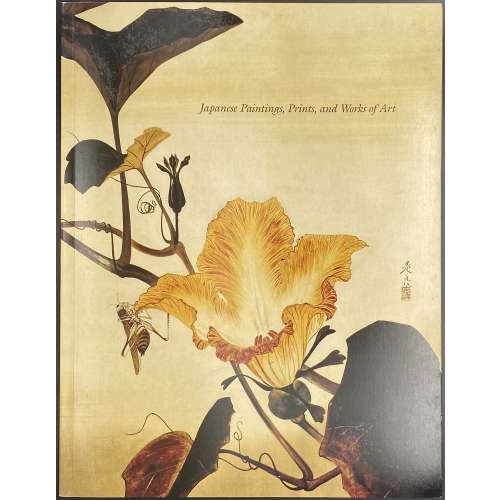 Softcover, in flapped pictorial wrappers, 28 x 21.7 cm, 16 entries, with colour illustrations. Catalogue # 5 of the sales exhibition on September 17-22, 2001 in NY; pagination: [1-3] 4-33 [3], ils. Contributor: Sebastian Izzard
Softcover, in flapped pictorial wrappers, 28 x 21.7 cm, 16 entries, with colour illustrations. Catalogue # 5 of the sales exhibition on September 17-22, 2001 in NY; pagination: [1-3] 4-33 [3], ils. Contributor: Sebastian Izzard -
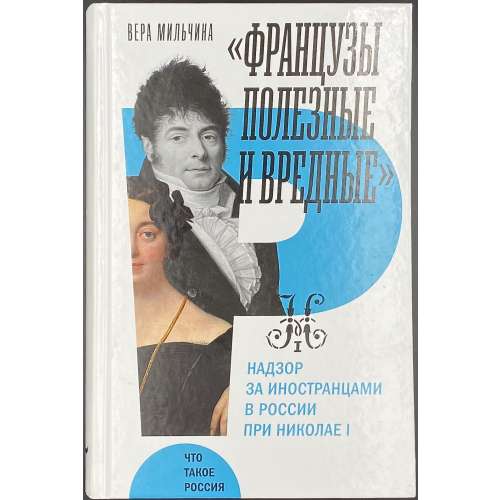 Description: One volume, 20.6 x 13.7 cm, pictorial glossy paper boards; pp.: [1-6] 7-480 [481] [7 advert.]; total 488 pages, ils. ISBN: 978-5-4448-0627-2. Contributor: Вера Аркадьевна Мильчина [Vera Miltchina] (Russian, b. 1953)
Description: One volume, 20.6 x 13.7 cm, pictorial glossy paper boards; pp.: [1-6] 7-480 [481] [7 advert.]; total 488 pages, ils. ISBN: 978-5-4448-0627-2. Contributor: Вера Аркадьевна Мильчина [Vera Miltchina] (Russian, b. 1953) -
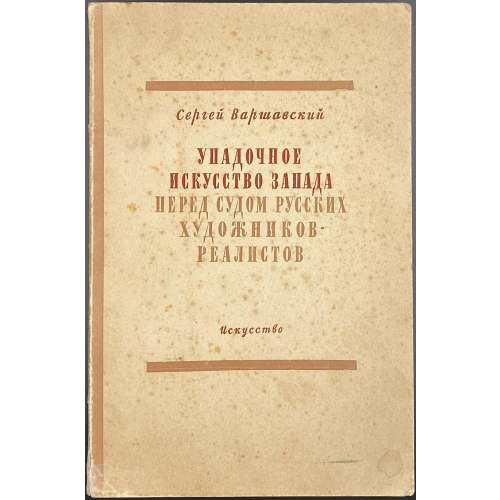 Description: Softcover, 8vo, 22 x 14.5 cm, tan wrappers, lettered in terra-cotta to spine and front wrapper: “Cергей Варшавский | УПАДОЧНОЕ | ИСКУССТВО ЗАПАДА | ПЕРЕД СУДОМ РУССКИХ | ХУДОЖНИКОВ- | РЕАЛИСТОВ | Искусство”, title in brown in a frame, blue ink autograph inscription: “Дорогому Толе | на память и на рецензию | с нежностью и любовью | 25.XII. 49. Сергей” (probably to his son Anatoly). Collation: 8vo, [1]-98 105; pp.: [2] 3-151 [3], total 154 pages, plus 4 plates extraneous to collation. Title-page: Cергей Варшавский | УПАДОЧНОЕ | ИСКУССТВО ЗАПАДА | ПЕРЕД СУДОМ | РУССКИХ ХУДОЖНИКОВ- | РЕАЛИСТОВ | Государственное издательство | «ИСКУССТВО» | Ленинград 1949 • Москва || T.p. verso: ОБЩАЯ РЕДАКЦИЯ | В. Я. БРОДСКОГО || Colophon: Редактор Н. Р. Мервольф, Художник И. С. Серов, и т.д. Тираж 10 000. Типография имени Володарского. Print run: 10,000 copies. Comment: the book was written and published to survive during the so-called “Anti-cosmopolitan campaign (Борьба с космополитизмом, Bor'ba s kosmopolitizmom) in 1948-53 in USSR during the Stalin’s rule. The author was later ashamed of writing it and never mentioned this book in his list of works. Contributors: Sergei Petrovich Varshavsky [Сергей Петрович Варшавский] (Jewish-Russian, 1906 – 1980).
Description: Softcover, 8vo, 22 x 14.5 cm, tan wrappers, lettered in terra-cotta to spine and front wrapper: “Cергей Варшавский | УПАДОЧНОЕ | ИСКУССТВО ЗАПАДА | ПЕРЕД СУДОМ РУССКИХ | ХУДОЖНИКОВ- | РЕАЛИСТОВ | Искусство”, title in brown in a frame, blue ink autograph inscription: “Дорогому Толе | на память и на рецензию | с нежностью и любовью | 25.XII. 49. Сергей” (probably to his son Anatoly). Collation: 8vo, [1]-98 105; pp.: [2] 3-151 [3], total 154 pages, plus 4 plates extraneous to collation. Title-page: Cергей Варшавский | УПАДОЧНОЕ | ИСКУССТВО ЗАПАДА | ПЕРЕД СУДОМ | РУССКИХ ХУДОЖНИКОВ- | РЕАЛИСТОВ | Государственное издательство | «ИСКУССТВО» | Ленинград 1949 • Москва || T.p. verso: ОБЩАЯ РЕДАКЦИЯ | В. Я. БРОДСКОГО || Colophon: Редактор Н. Р. Мервольф, Художник И. С. Серов, и т.д. Тираж 10 000. Типография имени Володарского. Print run: 10,000 copies. Comment: the book was written and published to survive during the so-called “Anti-cosmopolitan campaign (Борьба с космополитизмом, Bor'ba s kosmopolitizmom) in 1948-53 in USSR during the Stalin’s rule. The author was later ashamed of writing it and never mentioned this book in his list of works. Contributors: Sergei Petrovich Varshavsky [Сергей Петрович Варшавский] (Jewish-Russian, 1906 – 1980). -
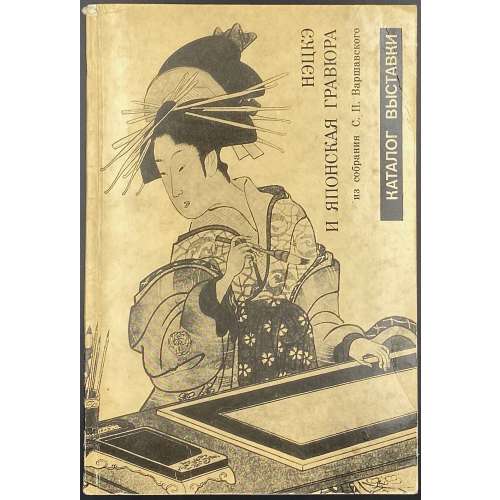 Mikhail Uspensky, Elena Varshavskaya. The netsuke and Japanese woodblock prints from the collection of S. P. Varshavsky. Printed by demand of The Hermitage Museum. Title-page (vertical bottom to top): ГОСУДАРСТВЕННЫЙ ОРДЕНА ЛЕНИНА | ЭРМИТАЖ | НЭЦКЭ | И ЯПОНСКАЯ | ГРАВЮРА | из собрания | С. П. Варшавского | КАТАЛОГ ВЫСТАВКИ | — | ЛЕНИНГРАД | “ИСКУССТВО” | ЛЕНИНГРАДСКОЕ ОТДЕЛЕНИЕ | 1983 | {vignette} || Description: Softcover, pictorial wrappers, 21.5 x 14.5 cm, pp.: [1-8] 9-42 [43-51] (b/w plates unpag.) [52] 53-76 [77-95] (b/w plates unpag.) [96] (colophon); total 96 pages plus four leaves of colour plates. Catalogue:137 entries of netsuke, 69 entries of Japanese woodblock prints. Print run: 3,000 copies. Contributors: Mikhail Uspensky [Михаил Владимирович Успенский] (Russian, 1953 – 1997) Elena Varshavsky [Елена Юрьевна Варшавская (Jewish-American, b. 1952) Vladislav Sisauri [Владислав Ираклиевич Сисаури] (Russian, b. 1944) Sergei Petrovich Varshavsky [Сергей Петрович Варшавский] (Jewish-Russian, 1906 – 1980).
Mikhail Uspensky, Elena Varshavskaya. The netsuke and Japanese woodblock prints from the collection of S. P. Varshavsky. Printed by demand of The Hermitage Museum. Title-page (vertical bottom to top): ГОСУДАРСТВЕННЫЙ ОРДЕНА ЛЕНИНА | ЭРМИТАЖ | НЭЦКЭ | И ЯПОНСКАЯ | ГРАВЮРА | из собрания | С. П. Варшавского | КАТАЛОГ ВЫСТАВКИ | — | ЛЕНИНГРАД | “ИСКУССТВО” | ЛЕНИНГРАДСКОЕ ОТДЕЛЕНИЕ | 1983 | {vignette} || Description: Softcover, pictorial wrappers, 21.5 x 14.5 cm, pp.: [1-8] 9-42 [43-51] (b/w plates unpag.) [52] 53-76 [77-95] (b/w plates unpag.) [96] (colophon); total 96 pages plus four leaves of colour plates. Catalogue:137 entries of netsuke, 69 entries of Japanese woodblock prints. Print run: 3,000 copies. Contributors: Mikhail Uspensky [Михаил Владимирович Успенский] (Russian, 1953 – 1997) Elena Varshavsky [Елена Юрьевна Варшавская (Jewish-American, b. 1952) Vladislav Sisauri [Владислав Ираклиевич Сисаури] (Russian, b. 1944) Sergei Petrovich Varshavsky [Сергей Петрович Варшавский] (Jewish-Russian, 1906 – 1980). -
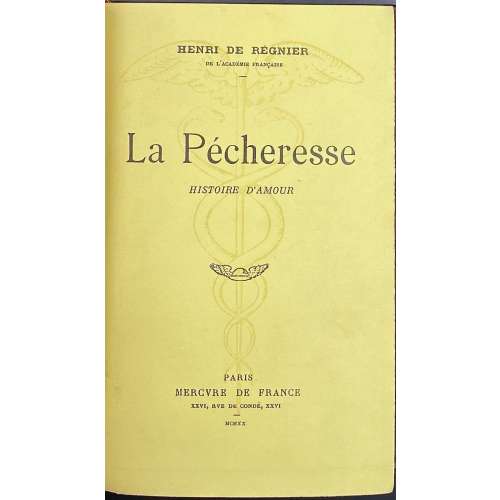 Hardcover volume, 19 x 13 cm, collated in-12mo, bound by Henri Creuzevault (signed) in full crushed brown morocco, spine with raised bands, gilt lettering “H. DE RÉGNIER | – | LA PÉCHERESSE” and “PARIS 1920” in the bottom compartment; gilt fillet to cover margin, five gilt fillets inside, marbled endpapers, bookplate of J.-P. Dutel to flyleaf, original yellow publisher’s wrappers preserved, top edge gilt, in a marbled slipcase; printed on dense wove paper (Japon). Inset: Receipt from Librairie ancienne et modern – Georges Venot (Lyon), dated April 16, 1938. Title-page / Cover: HENRI DE RÉGNIER | DE L’ACADÉMIE FRANÇAISE | – | La Pécheresse | HISTOIRE D’AMOUR | {publisher’s device} | PARIS | MERCVRE DE France | XXVI, RVE DE CONDÉ, XXVI | MCMXX || Limitation: 158 copies on Japon (№№ 1-158), 95 copies on Chine (№№ 159-253), 515 copies on Hollande (№№ 254-768), 1,650 copies on vélin pur fil de Lafuma (№№ 769-2393, and 25 copies not for sale marked A-Z. This is № 75 (on Japon), a unique copy enriched with 7 original watercolours by Serge de Solomko. Collation: 3 blank flyleaves, front wrapper, π6 (1 h.t./advert., 1 t.p./limit., 1 dedication, 3), 1-206, 212, back wrapper, spine, 3 blank flyleaves, list of illustrations pasted to recto endpaper “La Pécheresse. | 7 aquarelles de Solemko (sic.) | 57, 64, 168, 256, 289, 320, 346”, seven plates bound in as per the list. Pagination: [1-5] 6-350, ils. OCLC Number / Unique Identifier: 715077259. Contributors: Henri de Régnier (French, 1864 – 1936) – author. Auguste Gilbert de Voisins (1877 – 1939) – dedicatee. Sergueï Solomko [Сергей Сергеевич Соломко, Serge de Solomko] (Russian-French, 1867 – 1928) – artist. Henri Creuzevault (French, 1905 – 1971) – bookbinder. J.-P. Dutel description: RÉGNIER, Henri de. LA PECHERESSE. Paris, Mercure de France, 1920. In-12 (18,3 x 11,4 cm) de [1] f., 350 pp., maroquin janséniste grenat, dos à 5 nerfs, filets dorés intérieurs, tête dorée, filets dorés sur les coupes, non rogné, couverture et dos conservés, étui bordé. (Creuzevault). ÉDITION ORIGINALE. Tirage : 95 ex. sur chine. 158 ex. sur japon. 515 ex. sur hollande. UN DES 158 EXEMPLAIRES SUR JAPON. EXEMPLAIRE UNIQUE ENRICHI DE 7 AQUARELLES ORIGINALES HORS-TEXTE SIGNÉES PAR SERGE DE SOLOMKO. Sergueï Sergueïevitch Solomko « Serge de Solomko », (Saint-Petersburg, 1867- Sainte Geneviève des bois, 1928) est un illustrateur, graphiste et aquarelliste russe qui vécut en partie en France. Qualifiée d'histoire d'amour, cette œuvre d'Henri de Régnier est dédiée à Gilbert de Voisins, poète et romancier, en témoignage de fraternelle amitié. Elle est placée par son auteur sous les auspices du moraliste et critique libertin Saint-Evremond dont une citation figure en exergue du livre : « Il y a des temps où l'on pleure les plaisirs perdus, des temps où l'on pleure les péchés commis. » Et l'auteur d'incipiter comme suit : « J'ai toujours été si curieux des particularités que l'on découvre au caractère des femmes que, pas une fois, je n'ai négligé de m'instruire sur le sujet. » « (...) le point où se montre le mieux et le plus ouvertement ce que la nature les a faites, est celui de l'amour. »
Hardcover volume, 19 x 13 cm, collated in-12mo, bound by Henri Creuzevault (signed) in full crushed brown morocco, spine with raised bands, gilt lettering “H. DE RÉGNIER | – | LA PÉCHERESSE” and “PARIS 1920” in the bottom compartment; gilt fillet to cover margin, five gilt fillets inside, marbled endpapers, bookplate of J.-P. Dutel to flyleaf, original yellow publisher’s wrappers preserved, top edge gilt, in a marbled slipcase; printed on dense wove paper (Japon). Inset: Receipt from Librairie ancienne et modern – Georges Venot (Lyon), dated April 16, 1938. Title-page / Cover: HENRI DE RÉGNIER | DE L’ACADÉMIE FRANÇAISE | – | La Pécheresse | HISTOIRE D’AMOUR | {publisher’s device} | PARIS | MERCVRE DE France | XXVI, RVE DE CONDÉ, XXVI | MCMXX || Limitation: 158 copies on Japon (№№ 1-158), 95 copies on Chine (№№ 159-253), 515 copies on Hollande (№№ 254-768), 1,650 copies on vélin pur fil de Lafuma (№№ 769-2393, and 25 copies not for sale marked A-Z. This is № 75 (on Japon), a unique copy enriched with 7 original watercolours by Serge de Solomko. Collation: 3 blank flyleaves, front wrapper, π6 (1 h.t./advert., 1 t.p./limit., 1 dedication, 3), 1-206, 212, back wrapper, spine, 3 blank flyleaves, list of illustrations pasted to recto endpaper “La Pécheresse. | 7 aquarelles de Solemko (sic.) | 57, 64, 168, 256, 289, 320, 346”, seven plates bound in as per the list. Pagination: [1-5] 6-350, ils. OCLC Number / Unique Identifier: 715077259. Contributors: Henri de Régnier (French, 1864 – 1936) – author. Auguste Gilbert de Voisins (1877 – 1939) – dedicatee. Sergueï Solomko [Сергей Сергеевич Соломко, Serge de Solomko] (Russian-French, 1867 – 1928) – artist. Henri Creuzevault (French, 1905 – 1971) – bookbinder. J.-P. Dutel description: RÉGNIER, Henri de. LA PECHERESSE. Paris, Mercure de France, 1920. In-12 (18,3 x 11,4 cm) de [1] f., 350 pp., maroquin janséniste grenat, dos à 5 nerfs, filets dorés intérieurs, tête dorée, filets dorés sur les coupes, non rogné, couverture et dos conservés, étui bordé. (Creuzevault). ÉDITION ORIGINALE. Tirage : 95 ex. sur chine. 158 ex. sur japon. 515 ex. sur hollande. UN DES 158 EXEMPLAIRES SUR JAPON. EXEMPLAIRE UNIQUE ENRICHI DE 7 AQUARELLES ORIGINALES HORS-TEXTE SIGNÉES PAR SERGE DE SOLOMKO. Sergueï Sergueïevitch Solomko « Serge de Solomko », (Saint-Petersburg, 1867- Sainte Geneviève des bois, 1928) est un illustrateur, graphiste et aquarelliste russe qui vécut en partie en France. Qualifiée d'histoire d'amour, cette œuvre d'Henri de Régnier est dédiée à Gilbert de Voisins, poète et romancier, en témoignage de fraternelle amitié. Elle est placée par son auteur sous les auspices du moraliste et critique libertin Saint-Evremond dont une citation figure en exergue du livre : « Il y a des temps où l'on pleure les plaisirs perdus, des temps où l'on pleure les péchés commis. » Et l'auteur d'incipiter comme suit : « J'ai toujours été si curieux des particularités que l'on découvre au caractère des femmes que, pas une fois, je n'ai négligé de m'instruire sur le sujet. » « (...) le point où se montre le mieux et le plus ouvertement ce que la nature les a faites, est celui de l'amour. » -
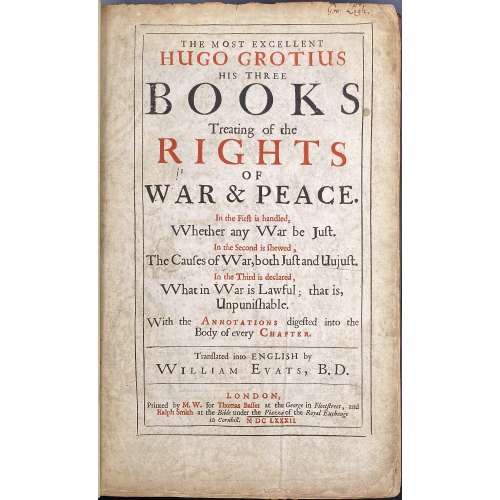 Volume collated 4to, 32.5 x 21 cm, later full calf, blind-tooled boards, sunned, raised bands and gilt lettering to spine. bound without the additional engraved title-page sometimes present; title printed in black and red, woodcut headpieces and initials; a little foxing (mostly marginal) throughout, title lightly dust stained with slight chipping at extremities, minor marginal worming to early leaves (b3-I4), paper flaw to outer margin of E1; contemporary English ownership inscription of George Legh to the title, a handful of manuscript corrections to text and annotations to index. Title-page (double frame, red and black, tall ‘s’): THE MOST EXCELLENT | HUGO GROTIUS | HIS THREE | BOOKS | Treating of the | RIGHTS | OF | WAR & PEACE. | In the First is handled, | Whether any War be Just. | In the Second is shewed , | The Causes of War, both Just and Uujust (sic). | In the Third is declared , | What in War is Lawful ; that is, | Unpunishable. | With the Annotations digested into the | Body of every Chapter. | — | Translated into ENGLISH by | William Evats, B. D. | — | LONDON, | Printed by M. W. for Thomas Basset at the George in Fleetstreet, and | Ralph Smith at the Bible under the Piazza of the Royal Exchange | in Cornhill. M DC LXXXII. || Collation: A4 a-b4 c3 B-Z4 2A-2D4 2E6 3A-3Z4 4A-4D4 4E-4L2; total 247 leaves as called for; lacking engraved title-page. Pagination: [4] i-xxi [5] 1-220 (text continuous) 361-572 [573] [574 blank] [30 table]; total 494 pages. Seller’s note: First edition of the first complete English translation, following Barksdale’s abridgement, of Grotius’s landmark work of political philosophy, the first treatise on international law. First published in Latin in 1625, Grotius’s De iure belli ac pacis “became the basic manual for both the theoretical justification and the entire practice of the international law of war as well as of international law in general for the whole period of the ancien régime in Europe” [Duchhardt, p. 288]. “It would be hard to imagine any work more central to the intellectual world of the Enlightenment … [By] the time of the post-First World War settlement, Grotius was regarded almost exclusively as the founder of modern civilized interstate relations, and as a suitable tutelary presence for the new Peace Palace at The Hague … [In] some ways that was to radically misunderstand Grotius’s views on war; he was in fact much more of an apologist for aggression and violence than many of his more genuinely innovative qualities of his moral theory, qualities that entitle him to an essential place in the history of political theory …” [Tuck, pp. xi-xii]. Contributors: Hugo Grotius (Dutch, 1583 – 1645) – author. William Evats (British, c.1606 – 1677) – translator. Margaret White (British, fl. 1678 – 1683) – printer. Thomas Bassett (British, fl. c. 1659 – 1693) – publisher/bookseller. Ralph Smith (British, fl. 1642 – 1684) – publisher/bookseller.
Volume collated 4to, 32.5 x 21 cm, later full calf, blind-tooled boards, sunned, raised bands and gilt lettering to spine. bound without the additional engraved title-page sometimes present; title printed in black and red, woodcut headpieces and initials; a little foxing (mostly marginal) throughout, title lightly dust stained with slight chipping at extremities, minor marginal worming to early leaves (b3-I4), paper flaw to outer margin of E1; contemporary English ownership inscription of George Legh to the title, a handful of manuscript corrections to text and annotations to index. Title-page (double frame, red and black, tall ‘s’): THE MOST EXCELLENT | HUGO GROTIUS | HIS THREE | BOOKS | Treating of the | RIGHTS | OF | WAR & PEACE. | In the First is handled, | Whether any War be Just. | In the Second is shewed , | The Causes of War, both Just and Uujust (sic). | In the Third is declared , | What in War is Lawful ; that is, | Unpunishable. | With the Annotations digested into the | Body of every Chapter. | — | Translated into ENGLISH by | William Evats, B. D. | — | LONDON, | Printed by M. W. for Thomas Basset at the George in Fleetstreet, and | Ralph Smith at the Bible under the Piazza of the Royal Exchange | in Cornhill. M DC LXXXII. || Collation: A4 a-b4 c3 B-Z4 2A-2D4 2E6 3A-3Z4 4A-4D4 4E-4L2; total 247 leaves as called for; lacking engraved title-page. Pagination: [4] i-xxi [5] 1-220 (text continuous) 361-572 [573] [574 blank] [30 table]; total 494 pages. Seller’s note: First edition of the first complete English translation, following Barksdale’s abridgement, of Grotius’s landmark work of political philosophy, the first treatise on international law. First published in Latin in 1625, Grotius’s De iure belli ac pacis “became the basic manual for both the theoretical justification and the entire practice of the international law of war as well as of international law in general for the whole period of the ancien régime in Europe” [Duchhardt, p. 288]. “It would be hard to imagine any work more central to the intellectual world of the Enlightenment … [By] the time of the post-First World War settlement, Grotius was regarded almost exclusively as the founder of modern civilized interstate relations, and as a suitable tutelary presence for the new Peace Palace at The Hague … [In] some ways that was to radically misunderstand Grotius’s views on war; he was in fact much more of an apologist for aggression and violence than many of his more genuinely innovative qualities of his moral theory, qualities that entitle him to an essential place in the history of political theory …” [Tuck, pp. xi-xii]. Contributors: Hugo Grotius (Dutch, 1583 – 1645) – author. William Evats (British, c.1606 – 1677) – translator. Margaret White (British, fl. 1678 – 1683) – printer. Thomas Bassett (British, fl. c. 1659 – 1693) – publisher/bookseller. Ralph Smith (British, fl. 1642 – 1684) – publisher/bookseller. -
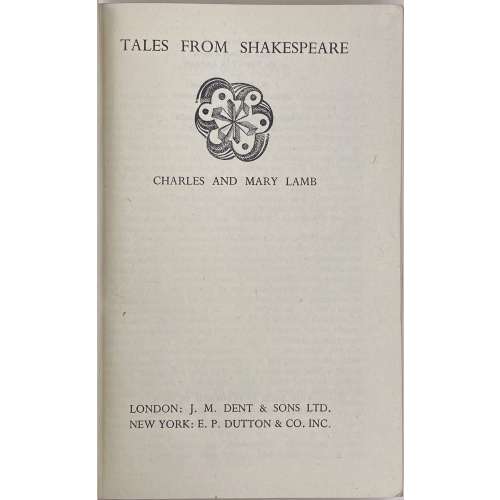 Description: 17.4 x 11 cm, blue publisher’s cloth, blind device to front board, gilt lettering to spine, no DJ, pink abstract diaper endpapers, owner’s ink inscription to ffep, dated June 28, 1945. Serial t.p.: Everyman, I will go with thee, and be thy guide, | In thy most need to go by the side. | — | EVERYMAN'S LIBRARY | EDITED BY ERNEST RHYS | No. 8 | FOR YOUNG PEOPLE | TALES FROM SHAKESPEARE | BY CHARLES AND MARY LAMB | ILLUSTRATIONS BY ARTHUR | RACKHAM || Title-page: TALES FROM SHAKESPEARE | {device} | CHARLES AND MARY LAMB | LONDON: J. M. DENT & SONS LTD. | NEW YORK: E. P. DUTTON & CO. INC. || T.p verso: All rights reserved | Made in Great Britain | at The Temple Press Letchworth | for | J. M. Dent & Sons Ltd. | Aldine House Bedford St. London | First published 1807 | First published in this edition 1906 | Last reprint (reset) 1944 | [blank] | THIS BOOK IS PRODUCED IN COM- | PLETE CONFORMITY WITH THE | AUTHORIZED ECONOMY STANDARDS || Collation: 16mo; [A]-K16; total 160 leaves, 9 full-page illustrations after Arthur Rackham, within collation (text on the other side). Pagination: [i-iv] v-viii, 1-312, total 320 pages, ils. Contributors: William Shakespeare (English, 1564 – 1616) Mary Ann Lamb (British, 1764 – 1847) – author. Charles Lamb (British, 1775 – 1834) – author. Ernest Percival Rhys (British, 1859 – 1946) – editor. Arthur Rackham (British, 1867 – 1939) – artist.
Description: 17.4 x 11 cm, blue publisher’s cloth, blind device to front board, gilt lettering to spine, no DJ, pink abstract diaper endpapers, owner’s ink inscription to ffep, dated June 28, 1945. Serial t.p.: Everyman, I will go with thee, and be thy guide, | In thy most need to go by the side. | — | EVERYMAN'S LIBRARY | EDITED BY ERNEST RHYS | No. 8 | FOR YOUNG PEOPLE | TALES FROM SHAKESPEARE | BY CHARLES AND MARY LAMB | ILLUSTRATIONS BY ARTHUR | RACKHAM || Title-page: TALES FROM SHAKESPEARE | {device} | CHARLES AND MARY LAMB | LONDON: J. M. DENT & SONS LTD. | NEW YORK: E. P. DUTTON & CO. INC. || T.p verso: All rights reserved | Made in Great Britain | at The Temple Press Letchworth | for | J. M. Dent & Sons Ltd. | Aldine House Bedford St. London | First published 1807 | First published in this edition 1906 | Last reprint (reset) 1944 | [blank] | THIS BOOK IS PRODUCED IN COM- | PLETE CONFORMITY WITH THE | AUTHORIZED ECONOMY STANDARDS || Collation: 16mo; [A]-K16; total 160 leaves, 9 full-page illustrations after Arthur Rackham, within collation (text on the other side). Pagination: [i-iv] v-viii, 1-312, total 320 pages, ils. Contributors: William Shakespeare (English, 1564 – 1616) Mary Ann Lamb (British, 1764 – 1847) – author. Charles Lamb (British, 1775 – 1834) – author. Ernest Percival Rhys (British, 1859 – 1946) – editor. Arthur Rackham (British, 1867 – 1939) – artist.Temple Press, Letchworth, England – printer.
Joseph Malaby Dent (British, 1849 – 1926) – publisher. Note: “On the writing desk were two books – identical copies of Lamb’s Tales From Shakespeare. […] — Why did you choose Lamb? — It was the only book I could find in duplicate except Uncle Tom’s Cabin…” Graham Greene. Our Man in Havana. -
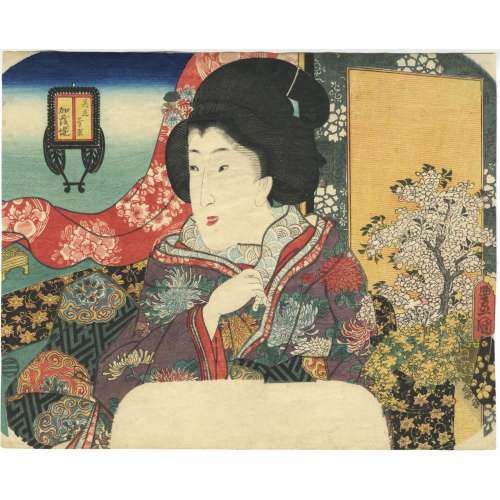 Title: On the Banks of the Kamo River [加茂堤] (Kamo Tsutsumi), sometimes transcribed as Kamo Zutsumi. Series: A Parody of Sugawara [美立菅原] (Mitate Sugawara). The word mitate is usually written as 見立 but here it is 美立, like on another Kunisada's fan print A beauty reading a book on a balcony overlooking a bay: A Parody of Sugawara Stripes (see SVJP-0334.2021 in this collection). On the Banks of the Kamo River is a scene from the play Sugawara's Secrets of Calligraphy [菅原伝授手習鑑] (Sugawara Denju Tenarai Kagami); it was originally written for the puppet theatre (Bunraku) and staged for the first time in the 8th lunar month of 1746 in Ôsaka at the Takemotoza. It was adapted for Kabuki the following month and staged for the first time in Kyôto at the Kitagawa no Shibai, produced by Nakamura Kiyosaburô I. It was also performed for the first time in Edo, at the Ichimuraza, in the 3rd lunar month of 1747. The shape of the cartouche resembles an ox cart viewed from the back which alludes to the scene Fighting for the Carriage (Kuruma biki). Artist: Utagawa Kunisada [歌川 国貞] a.k.a. Utagawa Toyokuni III [三代 歌川 豊国] (Japanese, 1786 – 1865). Signed: Toyokuni [豊国] in a red toshidama cartouche. The character ga [画] is missing (cut out). Publisher’s seal: Ibaya Senzaburō [伊場屋仙三郎] (Japanese, fl. 1815 – 1869). The date seal and censor seals were possibly trimmed out. According to [LIB-3008.2022] Andreas Marks (Tuttle, 2010; p. 267), the series was produced by Ibaya in 1851. Ref.: (1) Samuel L. Leiter. Historical dictionary of Japanese traditional theatre (Historical dictionaries of literature and the arts) / 2nd edition. – Lanham: Rowman & Littlefield, 2014©. (2) Andreas Marks. Japanese woodblock prints: Artists, publishers and masterworks, 1680 – 1900 / Foreword by Stephen Addiss. — Tuttle Publishing, 2010©. Acknowledgements: This masterpiece of ukiyo-e would not be properly described without input from Elena Varshavsky and Horst Graebner.
Title: On the Banks of the Kamo River [加茂堤] (Kamo Tsutsumi), sometimes transcribed as Kamo Zutsumi. Series: A Parody of Sugawara [美立菅原] (Mitate Sugawara). The word mitate is usually written as 見立 but here it is 美立, like on another Kunisada's fan print A beauty reading a book on a balcony overlooking a bay: A Parody of Sugawara Stripes (see SVJP-0334.2021 in this collection). On the Banks of the Kamo River is a scene from the play Sugawara's Secrets of Calligraphy [菅原伝授手習鑑] (Sugawara Denju Tenarai Kagami); it was originally written for the puppet theatre (Bunraku) and staged for the first time in the 8th lunar month of 1746 in Ôsaka at the Takemotoza. It was adapted for Kabuki the following month and staged for the first time in Kyôto at the Kitagawa no Shibai, produced by Nakamura Kiyosaburô I. It was also performed for the first time in Edo, at the Ichimuraza, in the 3rd lunar month of 1747. The shape of the cartouche resembles an ox cart viewed from the back which alludes to the scene Fighting for the Carriage (Kuruma biki). Artist: Utagawa Kunisada [歌川 国貞] a.k.a. Utagawa Toyokuni III [三代 歌川 豊国] (Japanese, 1786 – 1865). Signed: Toyokuni [豊国] in a red toshidama cartouche. The character ga [画] is missing (cut out). Publisher’s seal: Ibaya Senzaburō [伊場屋仙三郎] (Japanese, fl. 1815 – 1869). The date seal and censor seals were possibly trimmed out. According to [LIB-3008.2022] Andreas Marks (Tuttle, 2010; p. 267), the series was produced by Ibaya in 1851. Ref.: (1) Samuel L. Leiter. Historical dictionary of Japanese traditional theatre (Historical dictionaries of literature and the arts) / 2nd edition. – Lanham: Rowman & Littlefield, 2014©. (2) Andreas Marks. Japanese woodblock prints: Artists, publishers and masterworks, 1680 – 1900 / Foreword by Stephen Addiss. — Tuttle Publishing, 2010©. Acknowledgements: This masterpiece of ukiyo-e would not be properly described without input from Elena Varshavsky and Horst Graebner. -
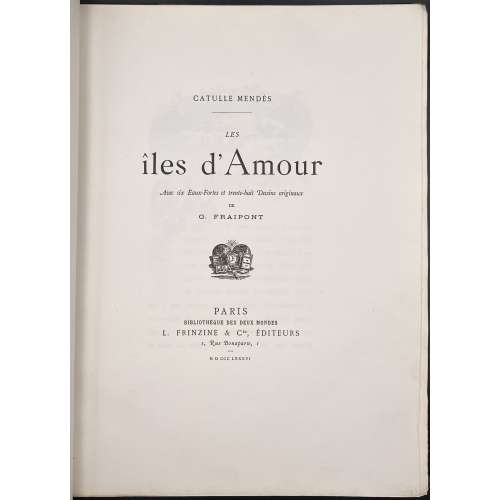 Description: Large volume collated in 4to, 33 x 25 cm, ¾ navy morocco bordered with a gilt double-fillet over marbled boards, raised bands, floral gilt arabesque in compartments, gilt lettering to spine, gilt endpapers, T.E.G. Text printed on wave paper watermarked “Whatman Turkey Mill 1884”; etchings printed on laid paper 32.2 x 24.3 cm, 20 x 13 platemark, 17 x 11 cm image; etched head- and tailpieces, initials. Printed on November 1, 1885. Title-page: CATULLE MENDÈS | — | LES | îles d'Amour | Avec six Eaux-Fortes et trente-huit Dessins originaux | DE | G. FRAIPONT | {publisher’s device} | PARIS | BIBLIOTHÈQUE DES DEUX MONDES | L. FRINZINE & Cie, ÉDITEURS | 1, Rue Bonaparte, 1 | – | M D CCC LXXXVI || Collation: 4to; π4, 1-114 122, total 50 leaves, two binder’s flyleaves in the front and in the back, and 6 plates extraneous to collation. Pagination: [i-v] vi-vii [viii] [1-3] 4-85 [86] [6], total 100 pages, ils. Limitation (printed in red and balck): 1000 copies on vergé (№ 1-1,000), 25 copies on Whatman (№ I-XXV), 15 copies on Japon Impérial (marked A-O). This is copy № III, signed by the publisher. Contributors: Catulle Mendès (French, 1841 – 1909) – author. Gustave Fraipont (Belgian-French, 1849 – 1923) – artist. Charles Unsinger (French, 1823 – 1891) – printer.
Description: Large volume collated in 4to, 33 x 25 cm, ¾ navy morocco bordered with a gilt double-fillet over marbled boards, raised bands, floral gilt arabesque in compartments, gilt lettering to spine, gilt endpapers, T.E.G. Text printed on wave paper watermarked “Whatman Turkey Mill 1884”; etchings printed on laid paper 32.2 x 24.3 cm, 20 x 13 platemark, 17 x 11 cm image; etched head- and tailpieces, initials. Printed on November 1, 1885. Title-page: CATULLE MENDÈS | — | LES | îles d'Amour | Avec six Eaux-Fortes et trente-huit Dessins originaux | DE | G. FRAIPONT | {publisher’s device} | PARIS | BIBLIOTHÈQUE DES DEUX MONDES | L. FRINZINE & Cie, ÉDITEURS | 1, Rue Bonaparte, 1 | – | M D CCC LXXXVI || Collation: 4to; π4, 1-114 122, total 50 leaves, two binder’s flyleaves in the front and in the back, and 6 plates extraneous to collation. Pagination: [i-v] vi-vii [viii] [1-3] 4-85 [86] [6], total 100 pages, ils. Limitation (printed in red and balck): 1000 copies on vergé (№ 1-1,000), 25 copies on Whatman (№ I-XXV), 15 copies on Japon Impérial (marked A-O). This is copy № III, signed by the publisher. Contributors: Catulle Mendès (French, 1841 – 1909) – author. Gustave Fraipont (Belgian-French, 1849 – 1923) – artist. Charles Unsinger (French, 1823 – 1891) – printer. -
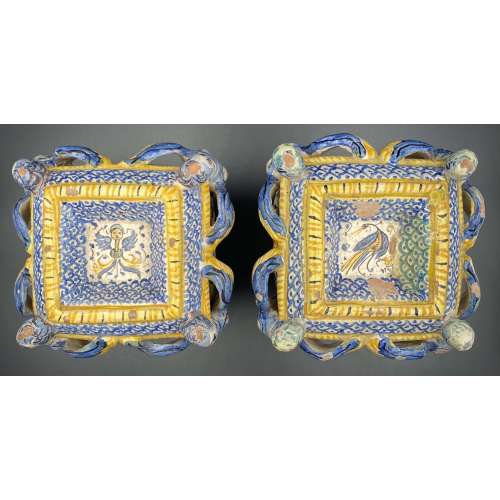 Tin-glazed earthenware salt cellars decorated with winged creatures and grotesque paintings. Restored, losses. Size: 16 x 16 cm; Height: 2.5 cm. Attributed to Deruta, Italy, c. 1600.
Tin-glazed earthenware salt cellars decorated with winged creatures and grotesque paintings. Restored, losses. Size: 16 x 16 cm; Height: 2.5 cm. Attributed to Deruta, Italy, c. 1600. -
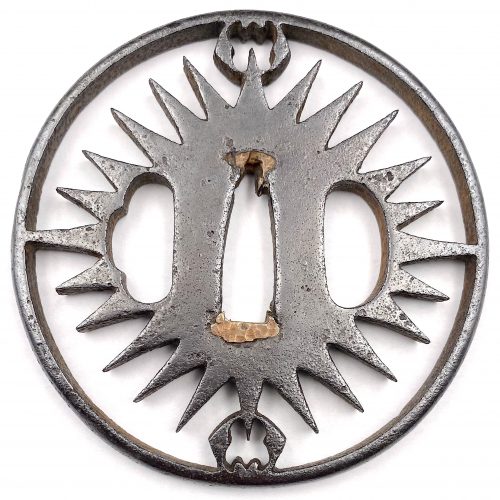 Iron tsuba of the round form (maru gata) with a grey patina pierced with the design of slanting rays of light (Jesuit’s IHS symbol) and a pair of ginger symbols [茗荷] (myōga) at top and bottom, in positive silhouette (ji-sukashi). This design is often called “tokei” [時計] or “clock gear”. Rounded rim, large hitsu-ana, copper fittings (sekigane). Unsigned, unpapered. Owari school. Early Edo period, early 17th century.
Iron tsuba of the round form (maru gata) with a grey patina pierced with the design of slanting rays of light (Jesuit’s IHS symbol) and a pair of ginger symbols [茗荷] (myōga) at top and bottom, in positive silhouette (ji-sukashi). This design is often called “tokei” [時計] or “clock gear”. Rounded rim, large hitsu-ana, copper fittings (sekigane). Unsigned, unpapered. Owari school. Early Edo period, early 17th century.Size: H 71.9 x W 71.1 x Th (centre) 5.5 cm.
For information regarding this type of tsuba see the article 'Kirishitan Ikenie Tsuba by Fred Geyer at Kokusai Tosogu Kai; The 2nd International Convention & Exhibition, October 18-23, 2006, pp. 84-91. 
IHS emblem of the Jesuits

茗荷 Myoga or Japanese ginger
-
 Iron tsuba of a spindle shape (tate-itomaki-gata) pierced and inlaid in brass suemon-zōgan with bellflowers, vines and foliage, and a dragonfly in the upper right corner, on both sides. One of the hitsu-ana plugged with grey metal (led or pewter), nakaga-ana fitted with copper sekigane. The shape of the tsuba may be interpreted as four saddles connected to each other by horse bits. Such a design of sukashi and zōgan is usually attributed to Kaga Yoshirō branch of Heianjo school, active in the second half of the 17th century (c. 1650-1700). Size: 95.9 mm diagonal; 4.1 mm thickness. Tokubetsu Kicho certificate № 332 issued by NBTHK on October 12, 1965.
Iron tsuba of a spindle shape (tate-itomaki-gata) pierced and inlaid in brass suemon-zōgan with bellflowers, vines and foliage, and a dragonfly in the upper right corner, on both sides. One of the hitsu-ana plugged with grey metal (led or pewter), nakaga-ana fitted with copper sekigane. The shape of the tsuba may be interpreted as four saddles connected to each other by horse bits. Such a design of sukashi and zōgan is usually attributed to Kaga Yoshirō branch of Heianjo school, active in the second half of the 17th century (c. 1650-1700). Size: 95.9 mm diagonal; 4.1 mm thickness. Tokubetsu Kicho certificate № 332 issued by NBTHK on October 12, 1965. -
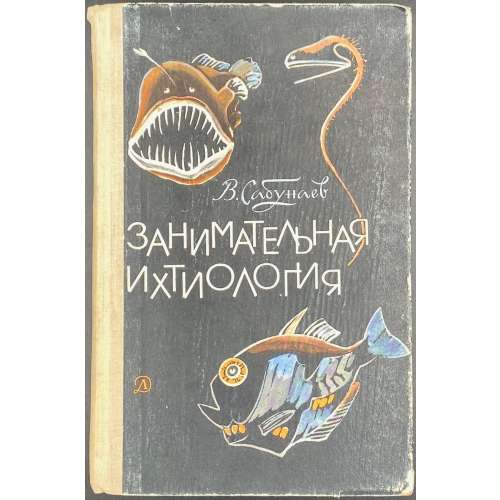 Hardcover, 20.5 x 13.5 cm, quarter cloth, pictorial boards, pp.: [2] 3-253 [3], ils., collated in-8vo: 1-188, total 128 leaves plus 2 leaves of colour plates. Title-page: В. САБУНАЕВ | ЗАНИМАТЕЛЬНАЯ | ИХТИОЛОГИЯ | {vignette} | ИЗДАТЕЛЬСТВО | “ДЕТСКАЯ ЛИТЕРАТУРА” | 1967. Print rub: 50,000 copies. Сабунаев, Виктор Борисович (Russian, 20th century) – author. Бианки, Елена Витальевна (Russian, 1922 – 2009) – artist.
Hardcover, 20.5 x 13.5 cm, quarter cloth, pictorial boards, pp.: [2] 3-253 [3], ils., collated in-8vo: 1-188, total 128 leaves plus 2 leaves of colour plates. Title-page: В. САБУНАЕВ | ЗАНИМАТЕЛЬНАЯ | ИХТИОЛОГИЯ | {vignette} | ИЗДАТЕЛЬСТВО | “ДЕТСКАЯ ЛИТЕРАТУРА” | 1967. Print rub: 50,000 copies. Сабунаев, Виктор Борисович (Russian, 20th century) – author. Бианки, Елена Витальевна (Russian, 1922 – 2009) – artist. -
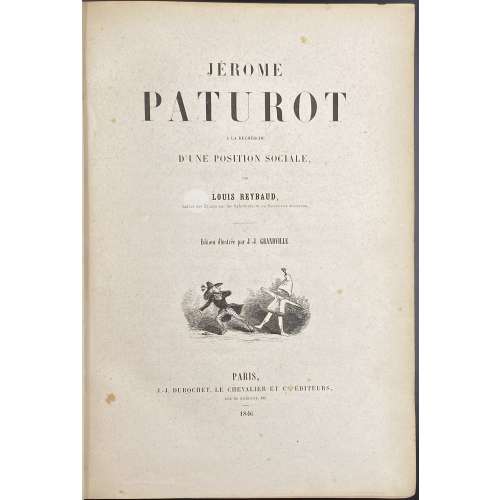 4to volume, ‘cartonnage percaline romantique’, 27.5 x 19.5 cm, green cloth with gilt fillet border and fictional coat of arms to front, border and fleuron to back, gilt and embossed vignette to spine, yellow endpapers, all edges gilt, 32 plates, incl. frontispiece, with tissue guards, and numerous in-text woodcuts after J.-J. Grandville by various engravers, mostly by Best, Leloir, Hotelin et Régnier group. Page 102 is numbered correctly. Title-page: JÉROME | PATUROT | A LA RECHERCHE | D'UNE POSITION SOCIALE | PAR | LOUIS REYBAUD, | Auteur des Études sur les Reformateurs ou Socialistes modernes. | — | Édition illustrée par J.-J. Grandville. | {vignette} | PARIS, | J.-J. DUBOCHET, LE CHEVALIER ET Cie, ÉDITEURS, | RUE DE RICHELIEU, 60. | – | 1846 || Collation: π4 1-574 582; total 234 leaves plus 32 wood-engraved plates extraneous to collation. Pagination: [8] [1] 2-460; total 468 pages, ils. Catalogue raisonné: L. Carteret 516; Ray 197 (pp. 277-8); Brivois: 350-1. Contributors: Louis Reybaud [Jérôme Paturot] (French, 1799 – 1879) – author. J.-J. Grandville [Isidore-Adolphe Gèrard] (French, 1803 – 1847) – artist. Schneider et Legrand (Paris) – printer. J.-J. Dubochet, Le Chevalier et Cie – publsiher. Engravers: Lucjan Stypulkowski (Polish, 1806 – 1849) Best, Leloir, Hotelin et Régnier Jean Baptiste Best (French, 1808 – 1879) or Adolphe Best (French, 1808 – 1860) Isidore Leloir (French, 1806 – 1851) Laurent Éloi Hotelin (French, 1821 – 1894) Eugène Laurent Isidore Régnier (?)
4to volume, ‘cartonnage percaline romantique’, 27.5 x 19.5 cm, green cloth with gilt fillet border and fictional coat of arms to front, border and fleuron to back, gilt and embossed vignette to spine, yellow endpapers, all edges gilt, 32 plates, incl. frontispiece, with tissue guards, and numerous in-text woodcuts after J.-J. Grandville by various engravers, mostly by Best, Leloir, Hotelin et Régnier group. Page 102 is numbered correctly. Title-page: JÉROME | PATUROT | A LA RECHERCHE | D'UNE POSITION SOCIALE | PAR | LOUIS REYBAUD, | Auteur des Études sur les Reformateurs ou Socialistes modernes. | — | Édition illustrée par J.-J. Grandville. | {vignette} | PARIS, | J.-J. DUBOCHET, LE CHEVALIER ET Cie, ÉDITEURS, | RUE DE RICHELIEU, 60. | – | 1846 || Collation: π4 1-574 582; total 234 leaves plus 32 wood-engraved plates extraneous to collation. Pagination: [8] [1] 2-460; total 468 pages, ils. Catalogue raisonné: L. Carteret 516; Ray 197 (pp. 277-8); Brivois: 350-1. Contributors: Louis Reybaud [Jérôme Paturot] (French, 1799 – 1879) – author. J.-J. Grandville [Isidore-Adolphe Gèrard] (French, 1803 – 1847) – artist. Schneider et Legrand (Paris) – printer. J.-J. Dubochet, Le Chevalier et Cie – publsiher. Engravers: Lucjan Stypulkowski (Polish, 1806 – 1849) Best, Leloir, Hotelin et Régnier Jean Baptiste Best (French, 1808 – 1879) or Adolphe Best (French, 1808 – 1860) Isidore Leloir (French, 1806 – 1851) Laurent Éloi Hotelin (French, 1821 – 1894) Eugène Laurent Isidore Régnier (?) -
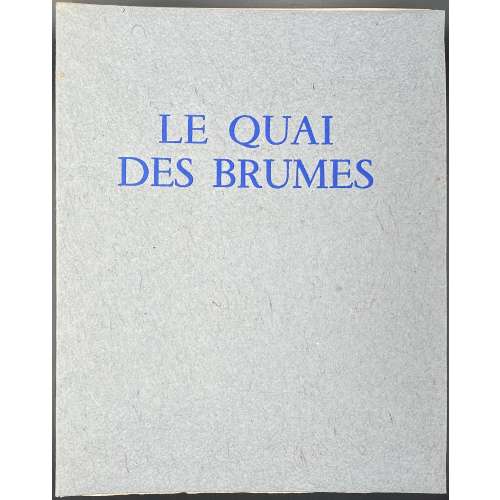 Description: One volume in-4to, 28.7 x 23 cm, in a grey double slipcase 29.6 x 24 cm, lettered paper label to spine, in publisher’s original French flapped blue wrappers, lettered on front, unbound, printed on thick wove paper watermarked "PUR FIL MARAIS". Illustrated with coloured two full-page plates and numerous in-text images, head- and tailpieces engraved by F. Nourisson after André Dignimont. Title-page (blue and black): PIERRE MAC ORLAN | LE QUAI | DES BRUMES | ILLUSTRATIONS DE | DIGNIMONT | ÉDITIONS ARC-EN-CIEL | M CM XLVIII || Pagination: [1-4] (h.t./frontis., t.p./copyright, 5-157 [158] [8] (plate, limit., colophon, blank); total 166 pages. Limitation: Printed in December 1948, engravings on Padovani press and text by Vibert. The edition is limited to 250 copies, № 1 unique on Japon nacré + original drawings and one suite, 28 copies (№ 2-29) on Vélin d’Arches + one drawing and one suite, 51 copies (№ 30-80) on Vélin de Lana + one suite, 170 copies (№ 81-250) on Vélin pur fil des Papeteries du Marais, 10 copies (№ I-X) on different papers for collaborators. This copy is № 115. Ref: WorldCat. Pierre Mac-Orlan (French, 1882 – 1970) – author. André Dignimont (French, 1891 – 1965) – artist.
Description: One volume in-4to, 28.7 x 23 cm, in a grey double slipcase 29.6 x 24 cm, lettered paper label to spine, in publisher’s original French flapped blue wrappers, lettered on front, unbound, printed on thick wove paper watermarked "PUR FIL MARAIS". Illustrated with coloured two full-page plates and numerous in-text images, head- and tailpieces engraved by F. Nourisson after André Dignimont. Title-page (blue and black): PIERRE MAC ORLAN | LE QUAI | DES BRUMES | ILLUSTRATIONS DE | DIGNIMONT | ÉDITIONS ARC-EN-CIEL | M CM XLVIII || Pagination: [1-4] (h.t./frontis., t.p./copyright, 5-157 [158] [8] (plate, limit., colophon, blank); total 166 pages. Limitation: Printed in December 1948, engravings on Padovani press and text by Vibert. The edition is limited to 250 copies, № 1 unique on Japon nacré + original drawings and one suite, 28 copies (№ 2-29) on Vélin d’Arches + one drawing and one suite, 51 copies (№ 30-80) on Vélin de Lana + one suite, 170 copies (№ 81-250) on Vélin pur fil des Papeteries du Marais, 10 copies (№ I-X) on different papers for collaborators. This copy is № 115. Ref: WorldCat. Pierre Mac-Orlan (French, 1882 – 1970) – author. André Dignimont (French, 1891 – 1965) – artist. -
 Title: Ninth lunar month [菊月] (Kikuzuki no zu); Series: Fashionable Twelve Months (Imayo juni-kagetsu). Another version of translation: Modern Beauties of Twelve Months. Artist: Utagawa Toyokuni I [歌川豊国] (1769–1825). Pubisher: Ibaya Senzaburō [伊場屋仙三郎] (Japanese, 1815 – 1869), seal: Dansendō [伊場仙]. Signed: Toyokuni ga and sealed with toshidama. Date-kiwame seal: Ushi (ox), Bunsei 5 (1822). Size: double-sheet uncut fan print ( aiban uchiwa-e), 219 x 295 mm.
Title: Ninth lunar month [菊月] (Kikuzuki no zu); Series: Fashionable Twelve Months (Imayo juni-kagetsu). Another version of translation: Modern Beauties of Twelve Months. Artist: Utagawa Toyokuni I [歌川豊国] (1769–1825). Pubisher: Ibaya Senzaburō [伊場屋仙三郎] (Japanese, 1815 – 1869), seal: Dansendō [伊場仙]. Signed: Toyokuni ga and sealed with toshidama. Date-kiwame seal: Ushi (ox), Bunsei 5 (1822). Size: double-sheet uncut fan print ( aiban uchiwa-e), 219 x 295 mm.

-
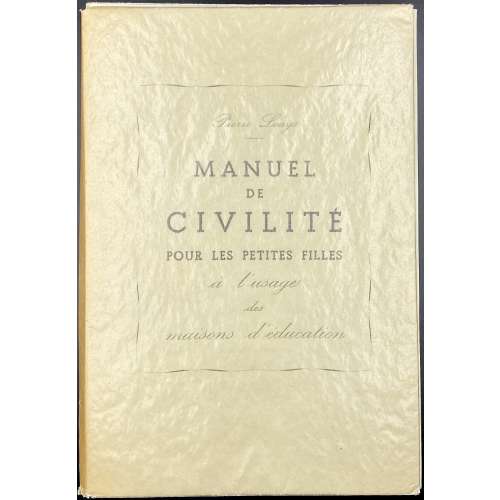 Description: Softcover 25 x 17 cm in the publisher’s French flapped wrappers lettered to front in black and green « Pierre Louys | MANUEL | DE | CIVILITÉ | POUR LES PETITES FILLES | à l'usage | des | maisons d'éducation » in a frame; unbound, 14 loose bifold wove paper (BFK Rives) sheets collated 4to, in glassine dust jacket, in slipcase; pp.: [1-10] 11-104 [8], total 56 leaves plus 12 laid-in plates after an anonymous artist’s watercolours and drawings reproduced by photogravure and stencil-coloured (au pochoir). Title-page: MANUEL | DE | CIVILITÉ | POUR LES PETITES FILLES | à l'usage | des | maisons d'éducation | ~ | LONDERS | MCMXLVIII || Limitation: 299 copies of which 1 copy (№ UN) on Vieux Japon enriched with the original watercolours and drawings and a b/w suite; 6 copies on Auvergne, each with one original watercolour and a b/w suite (№ I-VI); 6 copies on Auvergne each with one original drawing and a b/w suite (№ VII-XII); 15 copies on Auvergne enriched with a b/w suite (№ XVIII-XXVIII); 271 copies on Vélin de Rives (№ 1-271). This is copy № 91. Publisher, printer, artists – anonymous and unknown. Clandestine edition, marked "London", i.e. Nice, France. Catalogue raisonné: Dutel (1920-1970) № 1920, p. 251. For the original edition, see: LIB-3116.2022.
Description: Softcover 25 x 17 cm in the publisher’s French flapped wrappers lettered to front in black and green « Pierre Louys | MANUEL | DE | CIVILITÉ | POUR LES PETITES FILLES | à l'usage | des | maisons d'éducation » in a frame; unbound, 14 loose bifold wove paper (BFK Rives) sheets collated 4to, in glassine dust jacket, in slipcase; pp.: [1-10] 11-104 [8], total 56 leaves plus 12 laid-in plates after an anonymous artist’s watercolours and drawings reproduced by photogravure and stencil-coloured (au pochoir). Title-page: MANUEL | DE | CIVILITÉ | POUR LES PETITES FILLES | à l'usage | des | maisons d'éducation | ~ | LONDERS | MCMXLVIII || Limitation: 299 copies of which 1 copy (№ UN) on Vieux Japon enriched with the original watercolours and drawings and a b/w suite; 6 copies on Auvergne, each with one original watercolour and a b/w suite (№ I-VI); 6 copies on Auvergne each with one original drawing and a b/w suite (№ VII-XII); 15 copies on Auvergne enriched with a b/w suite (№ XVIII-XXVIII); 271 copies on Vélin de Rives (№ 1-271). This is copy № 91. Publisher, printer, artists – anonymous and unknown. Clandestine edition, marked "London", i.e. Nice, France. Catalogue raisonné: Dutel (1920-1970) № 1920, p. 251. For the original edition, see: LIB-3116.2022. -
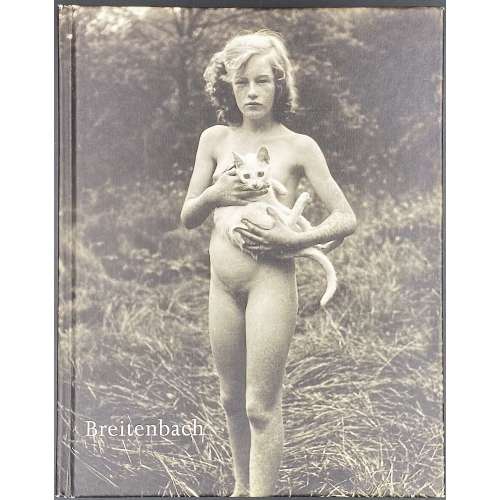 A pictorial photographic album, 19.5 x 15.3 cm, hardcover, paper pictorial covers, pictorial endpapers, pp. [2] 3-39 [40]; total 20 leaves; text by Susan Jacobasch, photographs by Josef Breitenbach. Published in connection with the exhibition "Josef Breitenbach" on October, 10 – November 28, 1998, at Galerie Bodo Niemann in Berlin. Josef Breitenbach (Jewish-German-American, 1896 – 1984).
A pictorial photographic album, 19.5 x 15.3 cm, hardcover, paper pictorial covers, pictorial endpapers, pp. [2] 3-39 [40]; total 20 leaves; text by Susan Jacobasch, photographs by Josef Breitenbach. Published in connection with the exhibition "Josef Breitenbach" on October, 10 – November 28, 1998, at Galerie Bodo Niemann in Berlin. Josef Breitenbach (Jewish-German-American, 1896 – 1984). -
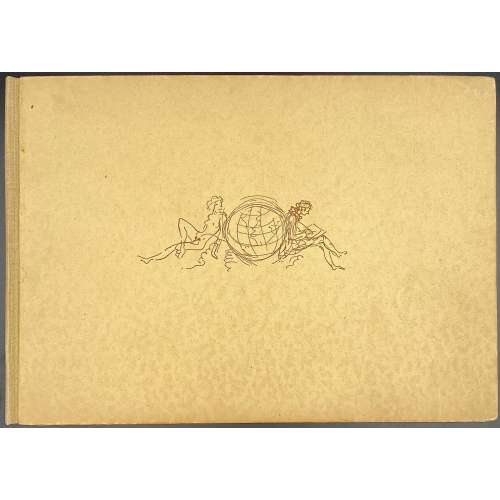 Title-page: JOHANN WOLFGANG GOETHE | DAS TAGEBUCH | Mit handkolorierten Zeichnungen von Max Schwimmer || Description: Oblong cardboard binding 24.5 x 17.5 cm, with sanguine vignette to front cover, 28 unpaginated leaves, 24 hand-coloured etchings on verso of each leaf with text on recto, numbered edition, this is № 549, signed by the artist (pencil). Contributors: Max Schwimmer (German, 1895 – 1960) – atrist. Johann Wolfgang von Goethe (German, 1749 – 1832) – author.
Title-page: JOHANN WOLFGANG GOETHE | DAS TAGEBUCH | Mit handkolorierten Zeichnungen von Max Schwimmer || Description: Oblong cardboard binding 24.5 x 17.5 cm, with sanguine vignette to front cover, 28 unpaginated leaves, 24 hand-coloured etchings on verso of each leaf with text on recto, numbered edition, this is № 549, signed by the artist (pencil). Contributors: Max Schwimmer (German, 1895 – 1960) – atrist. Johann Wolfgang von Goethe (German, 1749 – 1832) – author. -
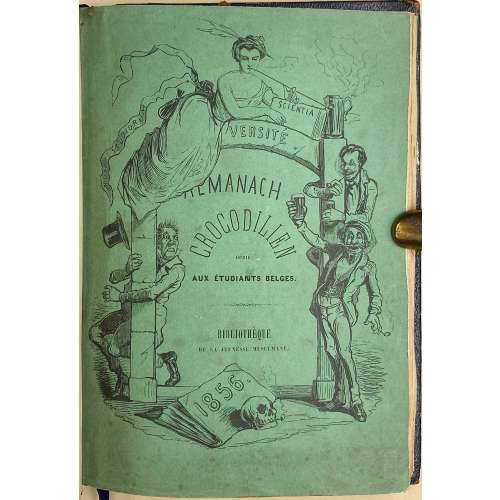 One volume collated 8vo, 19 x 14 cm, bound in black alligator leather. Front wrapper (green) / title-page (white): A female figure smoking a pipe next to a beer mug, reclining over an arch ring lettered “…VERSITÉ” (UNI… not shown), her dress ribbon lettered “MUSA STUDIORUM”, holding a book lettered “SCIENTIA”; within the arch « ALMANACH | CROCODILIEN | DÉDIÉ | AUX ÉTUDIANTS BELGES. | BIBLIOTHÈQUE | DE LA JEUNESSE MUSULMANE. »; below lies a book lettered “1856.”, next to it is a smoking skull; three male figures embracing the arch columns. Half-title: ALMANACH CROCODILIEN | POUR | L’ANNÉE BISSEXTILE, MAIS NÉANMOINS DE GRACE | 1856. || Pagination: [1-5] 6-14 [15-41] 42-134 [137] 138, total 136 pages within the wrappers, original publisher's green wrappers preserved, carte de visite ‘Félicien Rops, Étudiant’ and pink invitation card № 129 for ‘Bal des femmes’ on March 19, 1892 at ‘Fête annuelle du Courier Français’ bound in; in-text woodcuts, initials, head- and tail-pieces after Félicien Rops. Bookplate “Ex Libris Marcellus Schlimovich” with motto “Ars naturam adiuvat” on front pastedown. Stamp of the "Sociedad Hebraica Argentina / Coleccion M. Schlimovich / Varios / No. 2-492” to half-title. Pencil inscription to half-title: "Ex. Félicien Rops" – possibly an own copy of the artist. Collation: π2 1-88 92, total 68 leaves within wrappers. Printer: Typ. de J. Vanbuggenhoudt (Bruxelles). Sociedad Hebraica Argentina; Marcelo Schlimovich (Argentine-Jewish, ca. 1880 – 1960) – provenance. Félicien Rops (Belgian, 1833 – 1898) – artist.
One volume collated 8vo, 19 x 14 cm, bound in black alligator leather. Front wrapper (green) / title-page (white): A female figure smoking a pipe next to a beer mug, reclining over an arch ring lettered “…VERSITÉ” (UNI… not shown), her dress ribbon lettered “MUSA STUDIORUM”, holding a book lettered “SCIENTIA”; within the arch « ALMANACH | CROCODILIEN | DÉDIÉ | AUX ÉTUDIANTS BELGES. | BIBLIOTHÈQUE | DE LA JEUNESSE MUSULMANE. »; below lies a book lettered “1856.”, next to it is a smoking skull; three male figures embracing the arch columns. Half-title: ALMANACH CROCODILIEN | POUR | L’ANNÉE BISSEXTILE, MAIS NÉANMOINS DE GRACE | 1856. || Pagination: [1-5] 6-14 [15-41] 42-134 [137] 138, total 136 pages within the wrappers, original publisher's green wrappers preserved, carte de visite ‘Félicien Rops, Étudiant’ and pink invitation card № 129 for ‘Bal des femmes’ on March 19, 1892 at ‘Fête annuelle du Courier Français’ bound in; in-text woodcuts, initials, head- and tail-pieces after Félicien Rops. Bookplate “Ex Libris Marcellus Schlimovich” with motto “Ars naturam adiuvat” on front pastedown. Stamp of the "Sociedad Hebraica Argentina / Coleccion M. Schlimovich / Varios / No. 2-492” to half-title. Pencil inscription to half-title: "Ex. Félicien Rops" – possibly an own copy of the artist. Collation: π2 1-88 92, total 68 leaves within wrappers. Printer: Typ. de J. Vanbuggenhoudt (Bruxelles). Sociedad Hebraica Argentina; Marcelo Schlimovich (Argentine-Jewish, ca. 1880 – 1960) – provenance. Félicien Rops (Belgian, 1833 – 1898) – artist. -
 Artist: Utagawa Kunisada [歌川 国貞] a.k.a. Utagawa Toyokuni III [三代歌川豊国] (Japanese, 1786 – 1865). No publisher seal, no date or censor seal; probably a private printing. Signed: Kunisada ga [国貞画] in a red double gourd cartouche. Media: Untrimmed fan print (uchiwa-e), 231 x 294 mm, with the use of mica and black lacquer.
Artist: Utagawa Kunisada [歌川 国貞] a.k.a. Utagawa Toyokuni III [三代歌川豊国] (Japanese, 1786 – 1865). No publisher seal, no date or censor seal; probably a private printing. Signed: Kunisada ga [国貞画] in a red double gourd cartouche. Media: Untrimmed fan print (uchiwa-e), 231 x 294 mm, with the use of mica and black lacquer. -
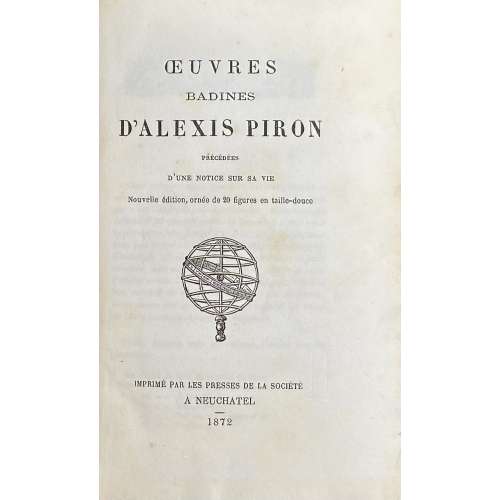 Single volume, 17.1 x 11.2 cm, quarter black sheepskin over faux chagrin, gilt lettering to spine, marbled endpapers, bottom and outer margin untrimmed, pp.: [i-v] vi- xxxvi, [1] 2-218 [2], collated 4to: π2, a-d4, 1-274 282, total 256 pages or 128 leaves, plus 20 engraved plates by Paul Sellier, including frontispiece portrait of Alexis Piron after bust by Caffieri. Vol. 8 of Bibliothèque Libre, Œuvres badines de Piron, printed on February 15, 1872. Text printed on dense wove paper watermarked P or M, plates printed on India wove paper. A reprint of an edition published in 1796 plus illustrations. Title-page: ŒUVRES | BADINES | D’ALEXIS PIRON | PRÉCÉDÉES | D’UNE NOTICE SUR SA VIE | Nouvelle édition, ornée de 20 figures en taille-douce | {vignette} | IMPRIMÉ PAR LES PRESSES DE LA SOCIÉTÉ | A NEUCHATEL | – | 1872 || Limitation: 100 numbered copies, of which this is № 75. Catalogue raisonné: Dutel I: A-788; Pia: 953-6; Kearney 377 (Patrick J. Kearney. A Catalogue of the publications of Jules Gay, Jean-Jules Gay & Gay et Doucé, revised & expanded. — Santa Rosa, CA Scissors & Paste Bibliographies, 2019) Catalogue Poulet-Malassis & ses amis description: № 81. Alexis PIRON. Œuvres badines précédées d’une notice sur sa vie. Nouvelle édition ornée de 20 figures en taille-douce. [ Jules Gay] Imprimé par les presses de la société, à Neufchatel, 1872. In-8, xxxvi, 218 pages et un feuillet d’achevé d’imprimer de table, demi-basane noire, dos à faux nerfs, tête et tranches naturelles. Illustré d’un portrait et de 20 figures par Paul Sellier. Tirage limité à 100 ex. numérotés. De la « Bibliothèque libre ou collection choisie d’ouvrages du genre libre, imprimés ou réimprimés par les soins de la Société des Bibliophiles Cosmopolites et pour les membres de cette société, à cent exemplaires numérotés ». Bibliographie : Pia 1030, Enfer 1274, Lem 3-454, Gay 5-339, PC 353, G* 38, Pey 203, Dutel A-788." Contributors: Alexis Piron (French, 1689 – 1773) – author. Paul Sellier (French, 1842 – 19..?) – artist. Jules Léopold Gay (French, 1807 – 1887) – publisher.
Single volume, 17.1 x 11.2 cm, quarter black sheepskin over faux chagrin, gilt lettering to spine, marbled endpapers, bottom and outer margin untrimmed, pp.: [i-v] vi- xxxvi, [1] 2-218 [2], collated 4to: π2, a-d4, 1-274 282, total 256 pages or 128 leaves, plus 20 engraved plates by Paul Sellier, including frontispiece portrait of Alexis Piron after bust by Caffieri. Vol. 8 of Bibliothèque Libre, Œuvres badines de Piron, printed on February 15, 1872. Text printed on dense wove paper watermarked P or M, plates printed on India wove paper. A reprint of an edition published in 1796 plus illustrations. Title-page: ŒUVRES | BADINES | D’ALEXIS PIRON | PRÉCÉDÉES | D’UNE NOTICE SUR SA VIE | Nouvelle édition, ornée de 20 figures en taille-douce | {vignette} | IMPRIMÉ PAR LES PRESSES DE LA SOCIÉTÉ | A NEUCHATEL | – | 1872 || Limitation: 100 numbered copies, of which this is № 75. Catalogue raisonné: Dutel I: A-788; Pia: 953-6; Kearney 377 (Patrick J. Kearney. A Catalogue of the publications of Jules Gay, Jean-Jules Gay & Gay et Doucé, revised & expanded. — Santa Rosa, CA Scissors & Paste Bibliographies, 2019) Catalogue Poulet-Malassis & ses amis description: № 81. Alexis PIRON. Œuvres badines précédées d’une notice sur sa vie. Nouvelle édition ornée de 20 figures en taille-douce. [ Jules Gay] Imprimé par les presses de la société, à Neufchatel, 1872. In-8, xxxvi, 218 pages et un feuillet d’achevé d’imprimer de table, demi-basane noire, dos à faux nerfs, tête et tranches naturelles. Illustré d’un portrait et de 20 figures par Paul Sellier. Tirage limité à 100 ex. numérotés. De la « Bibliothèque libre ou collection choisie d’ouvrages du genre libre, imprimés ou réimprimés par les soins de la Société des Bibliophiles Cosmopolites et pour les membres de cette société, à cent exemplaires numérotés ». Bibliographie : Pia 1030, Enfer 1274, Lem 3-454, Gay 5-339, PC 353, G* 38, Pey 203, Dutel A-788." Contributors: Alexis Piron (French, 1689 – 1773) – author. Paul Sellier (French, 1842 – 19..?) – artist. Jules Léopold Gay (French, 1807 – 1887) – publisher. -
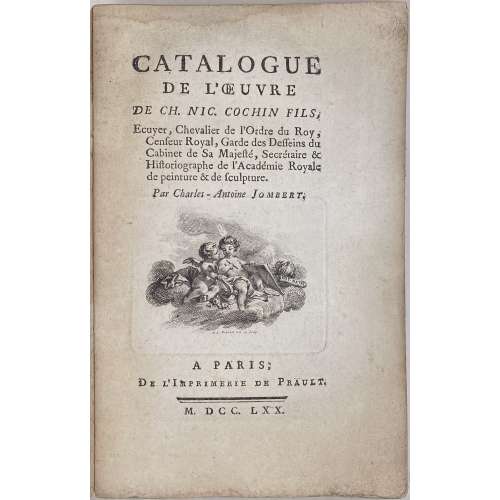 Description: one volume 20 x 12.8 cm, collated 8vo, in grey wrappers (original?), printed on laid paper, with tall “s”, two vignettes by Benoît-Louis Prévost to A1 and A3, 320 entries, where entry 320 Portraits et médaillons, consists of 121 entries itself. Title-page: CATALOGUE | DE L'ŒUVRE | DE CH. NIC. COCHIN FILS, | Ecuyer, Chevalier de l’Ordre du Roy, | Censeur Royal, Garde des Desseins du | Cabinet de Sa Majesté, Secrétaire & | Historiographe de l'Académie Royale | de peinture & de sculpture. | Par Charles-Antoine Jombert. | {vignette by Benoît-Louis Prévost} | A PARIS ; | De l’Imprimerie de Prault. | — | M. DCC. LXX. || Collation: A-I8, K1 (approbation), χ 8 (blanks), two in-text vignettes, total 81 leaves. Pagination: [1-5] 6-144 [145] [17 blanks], ils.; total 162 pages. Ref: Gallica-BnF. Contributors: Charles-Antoine Jombert (French, 1712 – 1784) – author. Charles Nicolas Cochin (French, 1715 – 1790) Benoît-Louis Prévost (French, 1735/47 – 1804) Laurent-François Prault (French, 1712 – 1780)
Description: one volume 20 x 12.8 cm, collated 8vo, in grey wrappers (original?), printed on laid paper, with tall “s”, two vignettes by Benoît-Louis Prévost to A1 and A3, 320 entries, where entry 320 Portraits et médaillons, consists of 121 entries itself. Title-page: CATALOGUE | DE L'ŒUVRE | DE CH. NIC. COCHIN FILS, | Ecuyer, Chevalier de l’Ordre du Roy, | Censeur Royal, Garde des Desseins du | Cabinet de Sa Majesté, Secrétaire & | Historiographe de l'Académie Royale | de peinture & de sculpture. | Par Charles-Antoine Jombert. | {vignette by Benoît-Louis Prévost} | A PARIS ; | De l’Imprimerie de Prault. | — | M. DCC. LXX. || Collation: A-I8, K1 (approbation), χ 8 (blanks), two in-text vignettes, total 81 leaves. Pagination: [1-5] 6-144 [145] [17 blanks], ils.; total 162 pages. Ref: Gallica-BnF. Contributors: Charles-Antoine Jombert (French, 1712 – 1784) – author. Charles Nicolas Cochin (French, 1715 – 1790) Benoît-Louis Prévost (French, 1735/47 – 1804) Laurent-François Prault (French, 1712 – 1780) -
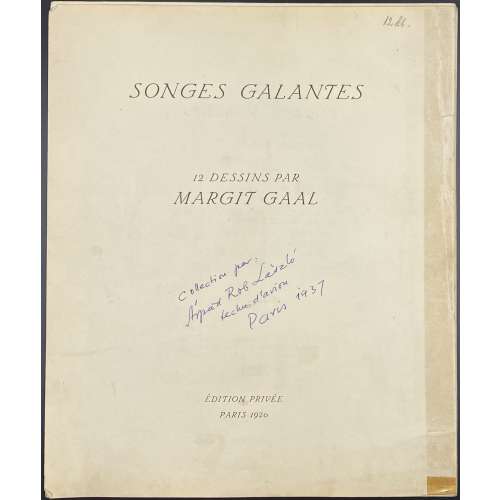 In an owner’s quarter buckram cardboard folder with a vegetation diaper design, ms blue ink lettering to front: “Songes galantes | 12 dessins par | Margit Gaal” at the centre, “Arpad Rob Laszlo | à Paris | 1938” in the lower right corner. Loose sheets with the 1st leaf t.p. / table de planches, and then 12 leaves of lithograph plates. Title-page: SONGES GALANTES | 12 DESSINS PAR | MARGIT GAAL | ÉDITION PRIVÉE | PARIS 1920 ||, ms inscription in blue ink in the middle : “Collection par | Árpad Rob Laśzló | techn. d’avion | Paris 1937”. Limitation: Edition limited to 500 copies of which № 1-100 signed by the author. This is copy № 407. References: Dutel (1920-1970) № 1413 (published in 1921); Honesterotica (indicated the year of death as 1965, however, there is no proof). Contributors: Gaál, Margit (Hungarian, 1898 – 1920) – artist.
In an owner’s quarter buckram cardboard folder with a vegetation diaper design, ms blue ink lettering to front: “Songes galantes | 12 dessins par | Margit Gaal” at the centre, “Arpad Rob Laszlo | à Paris | 1938” in the lower right corner. Loose sheets with the 1st leaf t.p. / table de planches, and then 12 leaves of lithograph plates. Title-page: SONGES GALANTES | 12 DESSINS PAR | MARGIT GAAL | ÉDITION PRIVÉE | PARIS 1920 ||, ms inscription in blue ink in the middle : “Collection par | Árpad Rob Laśzló | techn. d’avion | Paris 1937”. Limitation: Edition limited to 500 copies of which № 1-100 signed by the author. This is copy № 407. References: Dutel (1920-1970) № 1413 (published in 1921); Honesterotica (indicated the year of death as 1965, however, there is no proof). Contributors: Gaál, Margit (Hungarian, 1898 – 1920) – artist. -
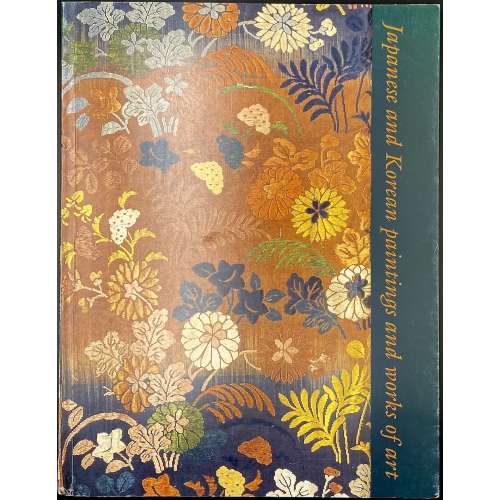 Softcover, in flapped pictorial wrappers, 28 x 21.6 cm, 35 entries, with colour illustrations. Catalogue # 6 of the sales exhibition on March 19-24, 2002 in NY; pagination: [1-3] 4-82 [2], ils., some folding. Contributor: Sebastian Izzard
Softcover, in flapped pictorial wrappers, 28 x 21.6 cm, 35 entries, with colour illustrations. Catalogue # 6 of the sales exhibition on March 19-24, 2002 in NY; pagination: [1-3] 4-82 [2], ils., some folding. Contributor: Sebastian Izzard -
 Iron tsuba of round form, slightly convex, decorated with persimmon (kaki), simplified Genji-kō (incense game symbol) and halves of plum blossoms (ume) in brass inlay on both sides, and with part of bellflower (kikyo) in openwork. Outer rim, seppa-dai, bellflower openwork, and kozuka-ana outlined with brass inlay; traces of lacquer to surface. The symbolic meaning alludes to Chapter 20: Asagao (朝顔, the bellflower or "morning face") of Tale of Genji by Murasaki Shikibu (11th century AD). The events take place in the 9th lunar month (Nagatsuki) and involve the following poetry by Prince Genji: saku hana ni / utsuru chō na wa / tsutsumedomo / orade sugiuki / kesa no asagao [I would not have it said / that my heart has turned toward / a flower in bloom — / yet how hard it is to pass / without plucking a “morning face”!]. Measurements: H: 76.6 mm; W: 76.3 mm; Th.: 3.6 mm (seppa-dai), 3.0 mm (rim) Time: Late Muromachi (1514 – 1573).
Iron tsuba of round form, slightly convex, decorated with persimmon (kaki), simplified Genji-kō (incense game symbol) and halves of plum blossoms (ume) in brass inlay on both sides, and with part of bellflower (kikyo) in openwork. Outer rim, seppa-dai, bellflower openwork, and kozuka-ana outlined with brass inlay; traces of lacquer to surface. The symbolic meaning alludes to Chapter 20: Asagao (朝顔, the bellflower or "morning face") of Tale of Genji by Murasaki Shikibu (11th century AD). The events take place in the 9th lunar month (Nagatsuki) and involve the following poetry by Prince Genji: saku hana ni / utsuru chō na wa / tsutsumedomo / orade sugiuki / kesa no asagao [I would not have it said / that my heart has turned toward / a flower in bloom — / yet how hard it is to pass / without plucking a “morning face”!]. Measurements: H: 76.6 mm; W: 76.3 mm; Th.: 3.6 mm (seppa-dai), 3.0 mm (rim) Time: Late Muromachi (1514 – 1573). -
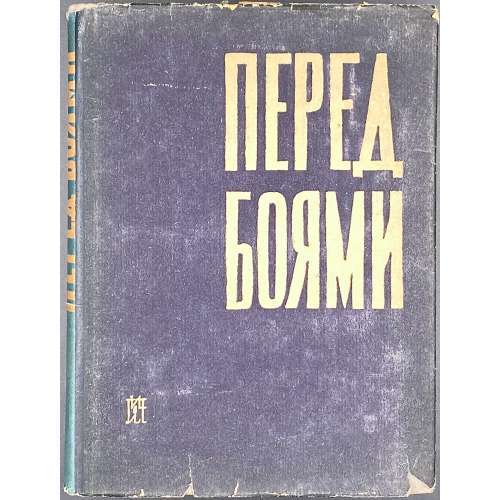 Sergei Petrovich Varshavsky [Сергей Петрович Варшавский] (Jewish-Russian, 1906 – 1980): «Цусима» (Tsushima) [対馬沖海戦], pp. 89-132. Description: Propaganda collection of short stories, hardcover, collated 8vo, [1]-158, 18 x 13 cm, bound in grey cloth with blind stamped lettering to front and blue lettering to spine, pp.: [1-4] 5-239 [240], dark blue dust jacket lettered to front, rear and spine. Title-page (red and black): ПЕРЕД БОЯМИ | ХУДОЖЕСТВЕННАЯ ЛИТЕРАТУРА НА ОБОРОНЕ СССР | СБОРНИК СТАТЕЙ | ПОД РЕД. Н. СВИРИНА. | Издательство писателей в Ленинграде || Print run: 5,500 copies.
Sergei Petrovich Varshavsky [Сергей Петрович Варшавский] (Jewish-Russian, 1906 – 1980): «Цусима» (Tsushima) [対馬沖海戦], pp. 89-132. Description: Propaganda collection of short stories, hardcover, collated 8vo, [1]-158, 18 x 13 cm, bound in grey cloth with blind stamped lettering to front and blue lettering to spine, pp.: [1-4] 5-239 [240], dark blue dust jacket lettered to front, rear and spine. Title-page (red and black): ПЕРЕД БОЯМИ | ХУДОЖЕСТВЕННАЯ ЛИТЕРАТУРА НА ОБОРОНЕ СССР | СБОРНИК СТАТЕЙ | ПОД РЕД. Н. СВИРИНА. | Издательство писателей в Ленинграде || Print run: 5,500 copies. -
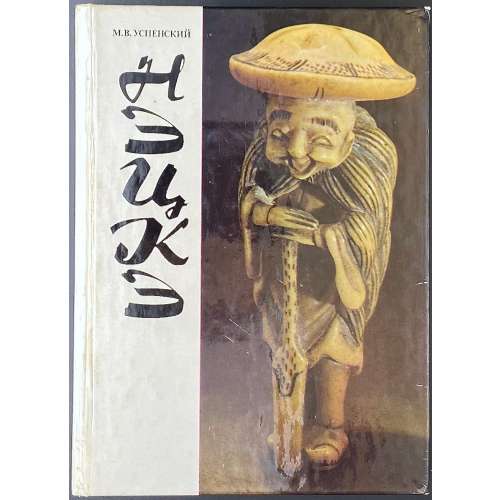 Mikhail Uspensky. Netsuke. Title-page: М. В. Успенский | — | НЭЦКЭ | {blank} | «Искусство» | Ленинградской отделение | 1986 || Hardcover, pictorial glossy paper, 17.2 x 12.6 cm; pp.: [2] 3-231 [232], 160 in-text b/w illustrations plus 16 leaves with 36 colour plates (pp. 233-263 unpag.) [264 colophon]; total 264 pages. Print run: 25,000 copies. Contributors: Uspensky, Mikhail [Успенский, Михаил Владимирович] (Russian, 1953 – 1997) Sisauri, Vladislav [Сисаури, Владислав Ираклиевич] (Russian, b. 1944)
Mikhail Uspensky. Netsuke. Title-page: М. В. Успенский | — | НЭЦКЭ | {blank} | «Искусство» | Ленинградской отделение | 1986 || Hardcover, pictorial glossy paper, 17.2 x 12.6 cm; pp.: [2] 3-231 [232], 160 in-text b/w illustrations plus 16 leaves with 36 colour plates (pp. 233-263 unpag.) [264 colophon]; total 264 pages. Print run: 25,000 copies. Contributors: Uspensky, Mikhail [Успенский, Михаил Владимирович] (Russian, 1953 – 1997) Sisauri, Vladislav [Сисаури, Владислав Ираклиевич] (Russian, b. 1944) -
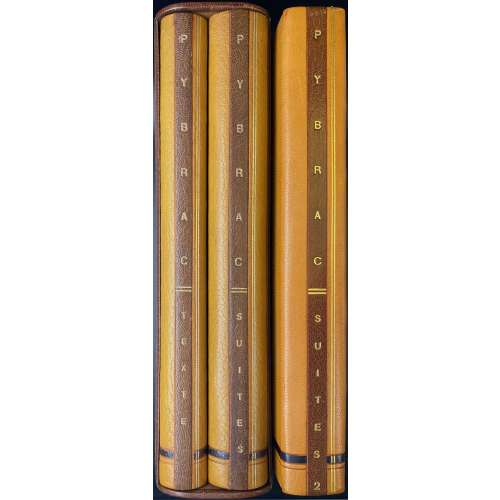 A three-volume unique copy of Louÿs’s poetical work ‘Pybrac’; edition published in 1928 by Marcel Vertès limited to 30 copies; contains 31 drypoints by Marcel Vertès, incl. frontispiece, nine full-page plates and twenty in-text vignettes; enriched with a volume of three suites of plates (first state b/w on Van Gelder paper, final state b/w on Japon nacré paper, final state hand-coloured on Van Gelder paper) plus 5 refused plates; and with a volume of one original watercolour, five ink drawings, three suites of plates (first state b/w on Van Gelder paper, final state b/w on Japon nacré paper, final state hand-coloured on Van Gelder paper) plus similar 5 refused plates, one b/w plate and one coloured plate, and a drypoint metal plate; two volumes of three are in a slipcase. Same edition in this collection: LIB-2919.2022. Details: (1) The ‘Texte’ volume, collated in-4to, 26 x 20.5 cm bound by Creuzevault (signed inside the front cover, in the bottom) in full tan morocco, blind fillets and a brown strip in the bottom to boards, double gilt fillet and a brown label along the spine, gilt-lettered vertically “PYBRAC | TEXTE”; gilt on black faux marbled endpapers, printed on watermarked Van Gelder Zonen laid paper; collated as follows: [3] blank flyleaves, [1] wrapper ‘PYBRAC’, [5] leaves with pasted original ink drawings on white paper, [1] leaf with pasted original hand-coloured ink drawings on blue paper, [1] drypoint frontispiece, [2] blank leaves, [1] half-title/limitation, [1] t.p., [2] blank leaves, 1-104 (pp. 1-78 [2]), [4] blank leaves plus nine full-page drypoint plates; total 70 leaves. Title-page: PYBRAC | ILLUSTRE DE TRENTE POINT SÈCHES | D’UN | ARTISTE INCONNU | PARIS | AUX DÉPENS D’UN AMATEUR | — | M. CM. XXVIII || Limitation: Edition limited to 30 copies; 1 copy unique on Japon Nacré with 30 original sketches, one suite in colour, two suites in black and 5 cancelled plates; 29 copies on Hollande Van Gelder, with one original watercolour, four original sketches, one suite in colour, two suites in black and 5 cancelled plates. This is copy № 12. (2) The ‘Suites’ volume, 26 x 20.5 cm, uniformly bound in quarter tan morocco over faux marbled paper, blind fillets, horizontal brown strip in the bottom, a vertical brown strip along the border, double gilt fillet and a brown label along the spine, gilt-lettered vertically “PYBRAC | SUITES”; gilt on black faux marbled endpapers; collated as follows: [3] blank flyleaves, three suites of prints: first state on Van Gelder paper, the final state on ‘Japon nacré’ paper, and hand-coloured final state on Van Gelder (31 x 3 = 93 leaves) plus [5] refused plates and [3] blank leaves; total 104 leaves. ‘Texte’ and ‘Suites’ volumes are placed in a faux marbled slipcase. (3) The ‘Suites 2’ volume, 26 x 21.5 cm, bound similarly to the ‘Suites’ volume (quarter morocco), gilt-lettered vertically “PYBRAC | SUITES 2” to spine; front cover with a hollow placement with the drypoint metal plate inside (plate #3), [3] blank wove paper leaves, [1] section title (s.t.) ‘AQUARELLE ORIGINALE’, [1] ink and crayon drawing, [1] s.t. ‘CROQUIS ORIGINAUX’, [5] ink drawings, [1] s.t. ‘PREMIER ÉTAT DES PLANCHES’, [31] plates on Van Gelder, [1] s.t. ‘SUITE EN NOIR SUR JAPON NACRÉ’, [31] plates, s.t. ‘SUITE COLORIÉE A LA MAIN’, [31] plates, [1] s.t. ‘PLANCHES REFUSÉS’, [5] plates, [1] coloured plate #13, [1] uncoloured plate #10, [3] wove paper blank leaves; total 118 leaves. Catalogue raisonné: Dutel (1920-70) № 2279 ; Fekete № 216; Nordmann (I) № 235; Vokaer 23. Ref.: honesterotica.com Contributors: Pierre Louÿs (French, 1870 – 1925) – author. Marcel Vertès [Marcell Vértes] (Jewish-Hungarian-French, 1895 – 1961) – artist. Henri Creuzevault (French, 1905 – 1971) – bookbinder. Seller's description: [ENRICHI & HORS-COMMERCE NON JUSTIFIÉ] Pierre LOUŸS - Marcel VERTÈS. Pybrac, illustré de trente pointes sèches d’un artiste inconnu. Paris, aux dépens d’un amateur, 1928. 3 volumes in-4 de 79 pages, 98 et 76 feuillets. Le volume contenant le texte est relié d'un plein chagrin havane à dos lisse, une pièce de titre en long et un filet doré à froid en bas (Creuzevault). Les deux autres volumes sont reliés à l'identiques, demi chagrin havane, dos lisse, pièce de titre en long, filets dorés sur le dos et filet doré à froid sur le bas et le long du mors. Le cuivre est placé dans le plat intérieur du volume 3, les suites dans le 2. Les deux premiers volumes sont rassemblés dans un étui. Illustré de 31 gravures originales dont 11 hors-texte par Marcel Vertès pour l’une des premières publications obscènes de Pierre Louÿs. Tirage à 30 exemplaires. La justification indique : "Il a été tiré de ce livre 30 exemplaires : 1 exemplaire unique sur Japon nacré avec trente croquis originaux, une suite en couleur, deux suites en noir et une épreuve des cinq planches refusées ; 29 exemplaires sur grand papier de Hollande Van Gelder avec une aquarelle originale, quatre croquis originaux, une suite en couleur, deux suites en noir et une épreuve des cinq planches refusées.". Exemplaire n°12 (Volume 1 Texte). Cet exemplaire est composé différemment soit : Volume 1, Texte : La couverture conservée, 5 dessins originaux à l'encre, 1 dessin sur papier bleu à l'estompe de couleur, le texte, les gravures in-texte et hors-texte. — Volume 2, Suites : les 31 planches en 3 états (1 en couleur et 2 en noir) et une épreuve des 5 planches refusées. — Volume 3, Suites 2 : 1 cuivre, 1 aquarelle, 5 dessins originaux à l'encre, 2 suites en noir, 1 suite coloriée à la main, 1 épreuve des 5 planches refusées, 1 dessin refusé à l'encre et à l'aquarelle et 1 dessin refusé à l'encre. Dutel précise : « Elle est ornée de 11 gravures originales hors-texte dont un titre et 20 gravures dans le texte par Marcel Vertès qui fut aussi l’éditeur de cet ouvrage. Il s’agit d’une des plus belles et des plus rares productions bibliophiliques de l’artiste. » Et surtout la plus rare… (Dutel 2279, pas à l’Enfer de la BnF).
A three-volume unique copy of Louÿs’s poetical work ‘Pybrac’; edition published in 1928 by Marcel Vertès limited to 30 copies; contains 31 drypoints by Marcel Vertès, incl. frontispiece, nine full-page plates and twenty in-text vignettes; enriched with a volume of three suites of plates (first state b/w on Van Gelder paper, final state b/w on Japon nacré paper, final state hand-coloured on Van Gelder paper) plus 5 refused plates; and with a volume of one original watercolour, five ink drawings, three suites of plates (first state b/w on Van Gelder paper, final state b/w on Japon nacré paper, final state hand-coloured on Van Gelder paper) plus similar 5 refused plates, one b/w plate and one coloured plate, and a drypoint metal plate; two volumes of three are in a slipcase. Same edition in this collection: LIB-2919.2022. Details: (1) The ‘Texte’ volume, collated in-4to, 26 x 20.5 cm bound by Creuzevault (signed inside the front cover, in the bottom) in full tan morocco, blind fillets and a brown strip in the bottom to boards, double gilt fillet and a brown label along the spine, gilt-lettered vertically “PYBRAC | TEXTE”; gilt on black faux marbled endpapers, printed on watermarked Van Gelder Zonen laid paper; collated as follows: [3] blank flyleaves, [1] wrapper ‘PYBRAC’, [5] leaves with pasted original ink drawings on white paper, [1] leaf with pasted original hand-coloured ink drawings on blue paper, [1] drypoint frontispiece, [2] blank leaves, [1] half-title/limitation, [1] t.p., [2] blank leaves, 1-104 (pp. 1-78 [2]), [4] blank leaves plus nine full-page drypoint plates; total 70 leaves. Title-page: PYBRAC | ILLUSTRE DE TRENTE POINT SÈCHES | D’UN | ARTISTE INCONNU | PARIS | AUX DÉPENS D’UN AMATEUR | — | M. CM. XXVIII || Limitation: Edition limited to 30 copies; 1 copy unique on Japon Nacré with 30 original sketches, one suite in colour, two suites in black and 5 cancelled plates; 29 copies on Hollande Van Gelder, with one original watercolour, four original sketches, one suite in colour, two suites in black and 5 cancelled plates. This is copy № 12. (2) The ‘Suites’ volume, 26 x 20.5 cm, uniformly bound in quarter tan morocco over faux marbled paper, blind fillets, horizontal brown strip in the bottom, a vertical brown strip along the border, double gilt fillet and a brown label along the spine, gilt-lettered vertically “PYBRAC | SUITES”; gilt on black faux marbled endpapers; collated as follows: [3] blank flyleaves, three suites of prints: first state on Van Gelder paper, the final state on ‘Japon nacré’ paper, and hand-coloured final state on Van Gelder (31 x 3 = 93 leaves) plus [5] refused plates and [3] blank leaves; total 104 leaves. ‘Texte’ and ‘Suites’ volumes are placed in a faux marbled slipcase. (3) The ‘Suites 2’ volume, 26 x 21.5 cm, bound similarly to the ‘Suites’ volume (quarter morocco), gilt-lettered vertically “PYBRAC | SUITES 2” to spine; front cover with a hollow placement with the drypoint metal plate inside (plate #3), [3] blank wove paper leaves, [1] section title (s.t.) ‘AQUARELLE ORIGINALE’, [1] ink and crayon drawing, [1] s.t. ‘CROQUIS ORIGINAUX’, [5] ink drawings, [1] s.t. ‘PREMIER ÉTAT DES PLANCHES’, [31] plates on Van Gelder, [1] s.t. ‘SUITE EN NOIR SUR JAPON NACRÉ’, [31] plates, s.t. ‘SUITE COLORIÉE A LA MAIN’, [31] plates, [1] s.t. ‘PLANCHES REFUSÉS’, [5] plates, [1] coloured plate #13, [1] uncoloured plate #10, [3] wove paper blank leaves; total 118 leaves. Catalogue raisonné: Dutel (1920-70) № 2279 ; Fekete № 216; Nordmann (I) № 235; Vokaer 23. Ref.: honesterotica.com Contributors: Pierre Louÿs (French, 1870 – 1925) – author. Marcel Vertès [Marcell Vértes] (Jewish-Hungarian-French, 1895 – 1961) – artist. Henri Creuzevault (French, 1905 – 1971) – bookbinder. Seller's description: [ENRICHI & HORS-COMMERCE NON JUSTIFIÉ] Pierre LOUŸS - Marcel VERTÈS. Pybrac, illustré de trente pointes sèches d’un artiste inconnu. Paris, aux dépens d’un amateur, 1928. 3 volumes in-4 de 79 pages, 98 et 76 feuillets. Le volume contenant le texte est relié d'un plein chagrin havane à dos lisse, une pièce de titre en long et un filet doré à froid en bas (Creuzevault). Les deux autres volumes sont reliés à l'identiques, demi chagrin havane, dos lisse, pièce de titre en long, filets dorés sur le dos et filet doré à froid sur le bas et le long du mors. Le cuivre est placé dans le plat intérieur du volume 3, les suites dans le 2. Les deux premiers volumes sont rassemblés dans un étui. Illustré de 31 gravures originales dont 11 hors-texte par Marcel Vertès pour l’une des premières publications obscènes de Pierre Louÿs. Tirage à 30 exemplaires. La justification indique : "Il a été tiré de ce livre 30 exemplaires : 1 exemplaire unique sur Japon nacré avec trente croquis originaux, une suite en couleur, deux suites en noir et une épreuve des cinq planches refusées ; 29 exemplaires sur grand papier de Hollande Van Gelder avec une aquarelle originale, quatre croquis originaux, une suite en couleur, deux suites en noir et une épreuve des cinq planches refusées.". Exemplaire n°12 (Volume 1 Texte). Cet exemplaire est composé différemment soit : Volume 1, Texte : La couverture conservée, 5 dessins originaux à l'encre, 1 dessin sur papier bleu à l'estompe de couleur, le texte, les gravures in-texte et hors-texte. — Volume 2, Suites : les 31 planches en 3 états (1 en couleur et 2 en noir) et une épreuve des 5 planches refusées. — Volume 3, Suites 2 : 1 cuivre, 1 aquarelle, 5 dessins originaux à l'encre, 2 suites en noir, 1 suite coloriée à la main, 1 épreuve des 5 planches refusées, 1 dessin refusé à l'encre et à l'aquarelle et 1 dessin refusé à l'encre. Dutel précise : « Elle est ornée de 11 gravures originales hors-texte dont un titre et 20 gravures dans le texte par Marcel Vertès qui fut aussi l’éditeur de cet ouvrage. Il s’agit d’une des plus belles et des plus rares productions bibliophiliques de l’artiste. » Et surtout la plus rare… (Dutel 2279, pas à l’Enfer de la BnF). -
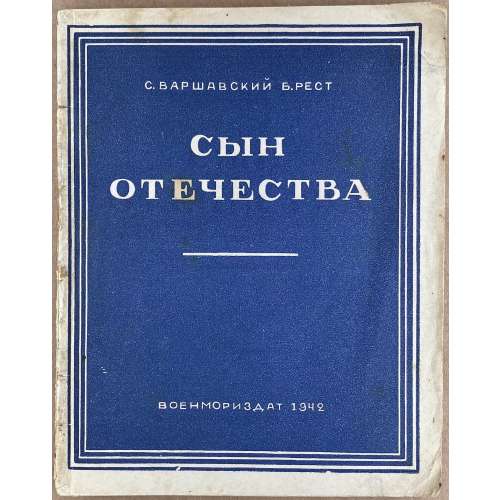 Description: softcover, 16.5 x 13 cm, in wrappers, white lettering on blue panel in white frame: “C. ВАРШАВСКИЙ Б. РЕСТ | СЫН | ОТЕЧЕСТВА | — | ВОЕНМОРИЗДАТ 1942”. Pagination: [2] 3-71 [72]; collated 8vo: [1]-48 54, total 36 leaves. Title-page: СМЕРТЬ НЕМЕЦКИМ ОККУПАНТАМ! | БИБЛИОТЕКА КРАСНОФЛОТЦА | C. ВАРШАВСКИЙ, Б. РЕСТ | СЫН | ОТЕЧЕСТВА | {publisher’s device} |—| ВОЕННО-МОРСКОЕ ИЗДАТЕЛЬСТВО НКВМФ СОЮЗА ССР | МОСКВА • 1942 || Autograph to t.p.: Дорогим друзьям | Тоне и Семе (скептику) | этот малый плод | военной эрзац-литературы | с любовью оставляет | Сергей | 3. XI. 42 || Another copy: LIB-3029.2022. Contributors: Сергей Петрович Варшавский [Sergei Varshavsky] (Russian-Jewish, 1906 – 1980) – author. Б. Рест (Юлий Исаакович Шапиро (Russian-Jewish, 1907 – 1984) – author.
Description: softcover, 16.5 x 13 cm, in wrappers, white lettering on blue panel in white frame: “C. ВАРШАВСКИЙ Б. РЕСТ | СЫН | ОТЕЧЕСТВА | — | ВОЕНМОРИЗДАТ 1942”. Pagination: [2] 3-71 [72]; collated 8vo: [1]-48 54, total 36 leaves. Title-page: СМЕРТЬ НЕМЕЦКИМ ОККУПАНТАМ! | БИБЛИОТЕКА КРАСНОФЛОТЦА | C. ВАРШАВСКИЙ, Б. РЕСТ | СЫН | ОТЕЧЕСТВА | {publisher’s device} |—| ВОЕННО-МОРСКОЕ ИЗДАТЕЛЬСТВО НКВМФ СОЮЗА ССР | МОСКВА • 1942 || Autograph to t.p.: Дорогим друзьям | Тоне и Семе (скептику) | этот малый плод | военной эрзац-литературы | с любовью оставляет | Сергей | 3. XI. 42 || Another copy: LIB-3029.2022. Contributors: Сергей Петрович Варшавский [Sergei Varshavsky] (Russian-Jewish, 1906 – 1980) – author. Б. Рест (Юлий Исаакович Шапиро (Russian-Jewish, 1907 – 1984) – author. -
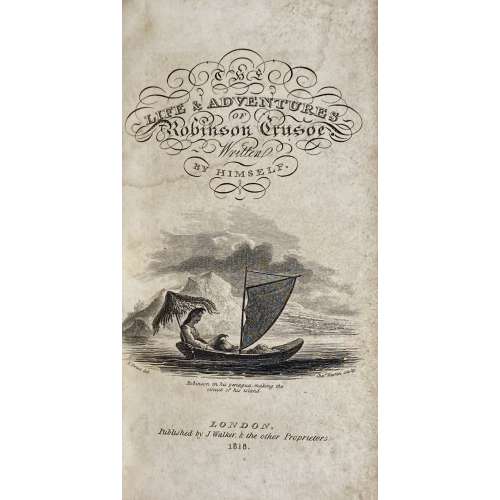 Description: 12mo, full calf, 12.9 x 7.4 cm, boards chain-bordered in gilt, front board gilt-lettered with the name of the owner “T. D. TOWNSEND”, flat spine, adorned in gilt, black label with gilt lettering, red endpapers, bookstore ticket to front pastedown: SOLD BY | ASH & MASON, | 139 Chesnut st.; ink ms inscription to ffep: Presented to | T. D. Townsend by | Mrs. Rebecca Cole of Burlington, N. Y. | Septr 29th 1827. Note: Ash & Mason bookstore and printing house in Philadelphia, PA. Engraved title-page: THE | LIFE & ADVENTURES | OF | Robinson Crusoe | Written | BY HIMSELF. | {vignette by C. Warren after T. Uwins, inscribed “Robinson on his periagua, making the circuit of his island”} | LONDON. | J. Walker & the other Proprietors | 1818. || Frontispiece: seated portrait of Robinson Crusoe in his bungalow with a dog and a cat by C. Warren after T. Uwins, inscribed below: ROBINSON CRUSOE | surrounded by his domestics || under the frame: T. Uwins del — C. Warren sculp.; beneath: London. Pub. by Walker & the other Proprietors || Title-page: THE | LIFE & ADVENTURES | OF | ROBINSON CRUSOE; | WRITTEN BY HIMSELF. | — | LONDON: | Printed for J. Walker; | 8 lines of names… and B. Reynolds. | 1818. || Collation: A6 (A1 torn out, A2 blank), B-Z12, 2A-2D12, 2E10 (2E8-10 blank); total 328 leaves plus two plates (engraved frontispiece and engraved title). Pagination: [2 torn out] [2 blank], [i-iii] iv-vi [2 blank] [1] 2-638 [6 blank]; total 656 pages, ill. Contributors: Daniel Defoe [Daniel De Foe] (British, 1660 – 1731) – author. Thomas Uwins (British, 1782 – 1857) – artist. Charles Warren (British, 1762 – 1823) – engraver. J Walker & Co. [Walker & Edwards] (London) – publisher. Ellerton and Henderson, Printers (London) – printer.
Description: 12mo, full calf, 12.9 x 7.4 cm, boards chain-bordered in gilt, front board gilt-lettered with the name of the owner “T. D. TOWNSEND”, flat spine, adorned in gilt, black label with gilt lettering, red endpapers, bookstore ticket to front pastedown: SOLD BY | ASH & MASON, | 139 Chesnut st.; ink ms inscription to ffep: Presented to | T. D. Townsend by | Mrs. Rebecca Cole of Burlington, N. Y. | Septr 29th 1827. Note: Ash & Mason bookstore and printing house in Philadelphia, PA. Engraved title-page: THE | LIFE & ADVENTURES | OF | Robinson Crusoe | Written | BY HIMSELF. | {vignette by C. Warren after T. Uwins, inscribed “Robinson on his periagua, making the circuit of his island”} | LONDON. | J. Walker & the other Proprietors | 1818. || Frontispiece: seated portrait of Robinson Crusoe in his bungalow with a dog and a cat by C. Warren after T. Uwins, inscribed below: ROBINSON CRUSOE | surrounded by his domestics || under the frame: T. Uwins del — C. Warren sculp.; beneath: London. Pub. by Walker & the other Proprietors || Title-page: THE | LIFE & ADVENTURES | OF | ROBINSON CRUSOE; | WRITTEN BY HIMSELF. | — | LONDON: | Printed for J. Walker; | 8 lines of names… and B. Reynolds. | 1818. || Collation: A6 (A1 torn out, A2 blank), B-Z12, 2A-2D12, 2E10 (2E8-10 blank); total 328 leaves plus two plates (engraved frontispiece and engraved title). Pagination: [2 torn out] [2 blank], [i-iii] iv-vi [2 blank] [1] 2-638 [6 blank]; total 656 pages, ill. Contributors: Daniel Defoe [Daniel De Foe] (British, 1660 – 1731) – author. Thomas Uwins (British, 1782 – 1857) – artist. Charles Warren (British, 1762 – 1823) – engraver. J Walker & Co. [Walker & Edwards] (London) – publisher. Ellerton and Henderson, Printers (London) – printer. -
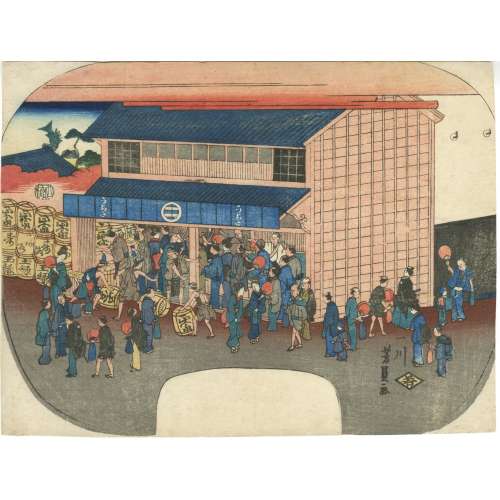 Artist: Utagawa Yoshikazu [歌川芳員] (Japanese, fl. c. 1850 – 1870). Publisher: Wakasaya Yoichi [若狭屋与市] (Japanese, fl. 1794 – 1897). Combined date seal and kiwame censor seal: 1861 (Man'en 2 / Bunkyū 1, from 19/02).
Artist: Utagawa Yoshikazu [歌川芳員] (Japanese, fl. c. 1850 – 1870). Publisher: Wakasaya Yoichi [若狭屋与市] (Japanese, fl. 1794 – 1897). Combined date seal and kiwame censor seal: 1861 (Man'en 2 / Bunkyū 1, from 19/02). -
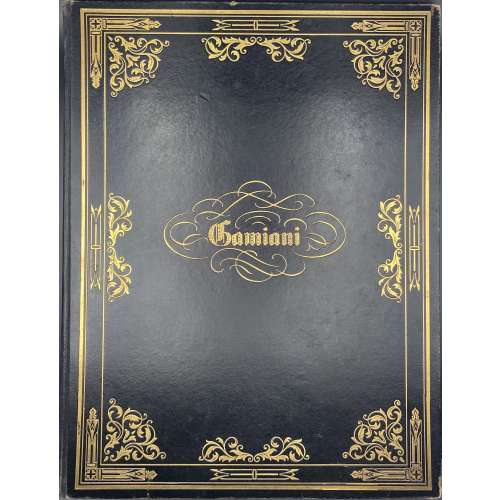 A German translation of de Musset’s “Gamiani ou deux nuits d’excès” illustrated with a reprint title-page and 11 (instead of 16) hand-coloured photogravures after original lithographs by Devéria and Henri Grévedon or Octave Tassaert for 1833 edition, though from the re-drawn stones. Large volume, 40.5 x 31 cm, collated 4to, in black calf with lettering and elaborate gilt border to front and blind border to back, outer and bottom margins uncut, marbled endpapers, text and plates printed on wove paper. The reprint t.p. is different from the original one; in the 1833 edition, the line deux nuits d’excès is waving while here it is straight. Letterpress title-page: ALFRED DE MUSSET | GAMIANI | ODER | ZWEI NÄCHTE DER AUSSCHWEIFUNG || Reprint title-page: Gamiani | OU | DEUX NUITS D’EXCÈS. | {vignette} | Bruxelles | 1833 || Collation: π2 1-74 82, total 32 leaves plus reprint t.p. and 11 plates. Pagination: [4] [1] 2-59 [60], total 64 pages, ils. Limitation: Edition limited to 300 numbered copies, of which this is copy № 32. Contributors: Alfred de Musset (French, 1810 – 1857) – author. Karl Spieler (German, 19th/20th century) – author of the foreword and translator. Achille Devéria (French, 1800 – 1857) – artist (attributed). Pierre Louis Henri Grévedon (French, 1776 – 1860) – artist (attributed). Octave Tassaert (French, 1800 – 1874) – artist (attributed). Catalogue raisonné: Dutel (1650-1880) № A-460, p. 149; Eros invaincu № 68, p. 171-3.
A German translation of de Musset’s “Gamiani ou deux nuits d’excès” illustrated with a reprint title-page and 11 (instead of 16) hand-coloured photogravures after original lithographs by Devéria and Henri Grévedon or Octave Tassaert for 1833 edition, though from the re-drawn stones. Large volume, 40.5 x 31 cm, collated 4to, in black calf with lettering and elaborate gilt border to front and blind border to back, outer and bottom margins uncut, marbled endpapers, text and plates printed on wove paper. The reprint t.p. is different from the original one; in the 1833 edition, the line deux nuits d’excès is waving while here it is straight. Letterpress title-page: ALFRED DE MUSSET | GAMIANI | ODER | ZWEI NÄCHTE DER AUSSCHWEIFUNG || Reprint title-page: Gamiani | OU | DEUX NUITS D’EXCÈS. | {vignette} | Bruxelles | 1833 || Collation: π2 1-74 82, total 32 leaves plus reprint t.p. and 11 plates. Pagination: [4] [1] 2-59 [60], total 64 pages, ils. Limitation: Edition limited to 300 numbered copies, of which this is copy № 32. Contributors: Alfred de Musset (French, 1810 – 1857) – author. Karl Spieler (German, 19th/20th century) – author of the foreword and translator. Achille Devéria (French, 1800 – 1857) – artist (attributed). Pierre Louis Henri Grévedon (French, 1776 – 1860) – artist (attributed). Octave Tassaert (French, 1800 – 1874) – artist (attributed). Catalogue raisonné: Dutel (1650-1880) № A-460, p. 149; Eros invaincu № 68, p. 171-3. -
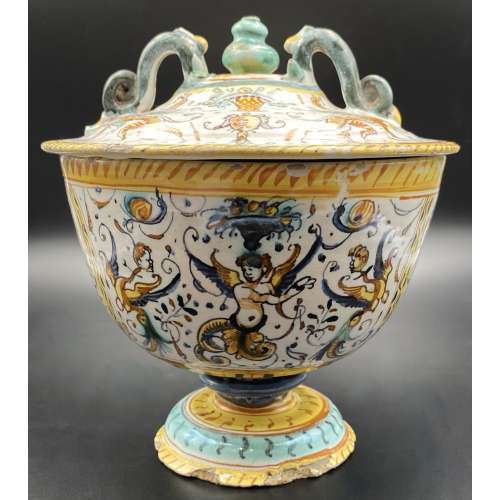 Tin-glazed earthenware footed lidded cup decorated with winged creatures and grotesque paintings, Bachus and Cupid inside. Minor losses Diameter: 16 cm; Height: 18 cm. Attributed to Deruta, Italy, c. 1600.
Tin-glazed earthenware footed lidded cup decorated with winged creatures and grotesque paintings, Bachus and Cupid inside. Minor losses Diameter: 16 cm; Height: 18 cm. Attributed to Deruta, Italy, c. 1600. -
 Series: Pictures Associated with the Iroha Syllabary [伊呂波画合]. Artist: Utagawa Kuniyoshi [歌川 國芳] (1798 – 1861). Signed: Ichiyûsai Kuniyoshi giga [一勇斎 國芳戯画] (Playfully drawn by Ichiyūsai Kuniyoshi) in a red double-gourd cartouche with a kiri-mon seal beneath. Publisher: Iseya Ichiemon [伊勢屋市右衛門] (Japanese, fl. 1823 – c. 1864); seal [辻] (Marks 16-029 | 143a). Single nanushi censor seal: Mura [村] = Murata Sahei [村田佐右衛] (VI/1842 – V/1846). Media: Fan print (uchiwa-e, 団扇絵), 231 x 296 mm. Theme: The Treasury of Loyal Retainers [仮名手本忠臣蔵] (Kanadehon Chūshingura) – an 11-act puppet play composed in 1748, based on a historical event. "Most historians now agree that there were forty-seven rōnin of Ako who attacked and killed Kira Yoshinaka (吉良 義央, 1641 – 1703) in Edo in the twelfth month of 1702, twenty-two months after their lord Asano Naganori (浅野 長矩, 1667 – 1701) had been put to death for his own failed attempt on Kira’s life". [Henry D. SMITH II. The Trouble with Terasaka: The Forty-Seventh Rōnin and the Chūshingura Imagination / Japan Review, 2004, 16:3-65]. The reader shall remember that the fictional, romantic version of the Akō incident [赤穂事件] (Akō jiken) may not (and most probably does not) reflect the historical truth of events. Uncut fan print depicting a beautiful young woman covering another woman's mouth with a blue striped cloth, possibly an obi. The picture on the wall represents the scene from the final act of The Treasury of Loyal Retainers (Kanadehon Chūshingura, Act 11) when 47 loyal retainers (rōnin) of the late lord En'ya Hangan came to the house of Kō no Moronao in order to avenge their dead master. The leader of 47 rōnin, Ōboshi Yuranosuke, divided his accomplices into several groups which attacked the Moronao mansion from different directions. To coordinate the attack and keep communication among the groups, the rōnin were signing the first syllables of their names in the hiragana syllabary. There are two major types of the ordering of the hiragana syllabary, the Gojūon one and the Iroha order (pangram poem), the latter being used here. The number of avengers exactly matches the 47 letters of that syllabary. The group entering Moronao's house from the front gate was 'chi-ri-nu-ru-wo-wa-ka'. Yoshida Sadaemon Kanesada [葦田貞右衛門兼貞] (1675 – 1703) depicted on this fan print belongs to this group. The character on the lantern hanging from Yoshida's spear reads Chū [忠] – for Chūshingura. Alternating black and white triangles on the picture frame allude to the 'signature' 47 ronin's uniform. This motif is usually described as a zigzag pattern [雁木模様] (gangi moyō), a mountain-shaped pattern [山形模様] (yamagata moyō), or a mountain road [山道] (yamamichi). The rōnin were allegedly wearing this uniform in imitation of firefighters. The government allowed the firefighters alone to gather in large groups and carry equipment akin to that of the military. Such equipment was necessary for firemen to tear down the burning buildings to stop the flames. The design can be seen in Kunimaru's fan print [SVJP-0233.2018] in this collection.Fighting Moronao's guards, the 47 rōnin entered the mansion and searched for their enemy but in vain. Finally, Yazama Jujiro Motooki [矢間重次郎元興] found the villain in the charcoal chamber and called his friends. This is the exact moment we see in the picture on the wall: Yoshida entering the charcoal chamber with a spear in his hand amid falling baskets and charcoal. Kō no Moronao was brought to justice and beheaded; his head was offered before the memorial tablet of En'ya Hangan to appease his spirit. After that, Ōboshi Yuranosuke and his 46 friends committed seppuku. They were buried at Sengakuji (泉岳寺) – a small temple near Shinagawa in Edo (Tokyo).
Series: Pictures Associated with the Iroha Syllabary [伊呂波画合]. Artist: Utagawa Kuniyoshi [歌川 國芳] (1798 – 1861). Signed: Ichiyûsai Kuniyoshi giga [一勇斎 國芳戯画] (Playfully drawn by Ichiyūsai Kuniyoshi) in a red double-gourd cartouche with a kiri-mon seal beneath. Publisher: Iseya Ichiemon [伊勢屋市右衛門] (Japanese, fl. 1823 – c. 1864); seal [辻] (Marks 16-029 | 143a). Single nanushi censor seal: Mura [村] = Murata Sahei [村田佐右衛] (VI/1842 – V/1846). Media: Fan print (uchiwa-e, 団扇絵), 231 x 296 mm. Theme: The Treasury of Loyal Retainers [仮名手本忠臣蔵] (Kanadehon Chūshingura) – an 11-act puppet play composed in 1748, based on a historical event. "Most historians now agree that there were forty-seven rōnin of Ako who attacked and killed Kira Yoshinaka (吉良 義央, 1641 – 1703) in Edo in the twelfth month of 1702, twenty-two months after their lord Asano Naganori (浅野 長矩, 1667 – 1701) had been put to death for his own failed attempt on Kira’s life". [Henry D. SMITH II. The Trouble with Terasaka: The Forty-Seventh Rōnin and the Chūshingura Imagination / Japan Review, 2004, 16:3-65]. The reader shall remember that the fictional, romantic version of the Akō incident [赤穂事件] (Akō jiken) may not (and most probably does not) reflect the historical truth of events. Uncut fan print depicting a beautiful young woman covering another woman's mouth with a blue striped cloth, possibly an obi. The picture on the wall represents the scene from the final act of The Treasury of Loyal Retainers (Kanadehon Chūshingura, Act 11) when 47 loyal retainers (rōnin) of the late lord En'ya Hangan came to the house of Kō no Moronao in order to avenge their dead master. The leader of 47 rōnin, Ōboshi Yuranosuke, divided his accomplices into several groups which attacked the Moronao mansion from different directions. To coordinate the attack and keep communication among the groups, the rōnin were signing the first syllables of their names in the hiragana syllabary. There are two major types of the ordering of the hiragana syllabary, the Gojūon one and the Iroha order (pangram poem), the latter being used here. The number of avengers exactly matches the 47 letters of that syllabary. The group entering Moronao's house from the front gate was 'chi-ri-nu-ru-wo-wa-ka'. Yoshida Sadaemon Kanesada [葦田貞右衛門兼貞] (1675 – 1703) depicted on this fan print belongs to this group. The character on the lantern hanging from Yoshida's spear reads Chū [忠] – for Chūshingura. Alternating black and white triangles on the picture frame allude to the 'signature' 47 ronin's uniform. This motif is usually described as a zigzag pattern [雁木模様] (gangi moyō), a mountain-shaped pattern [山形模様] (yamagata moyō), or a mountain road [山道] (yamamichi). The rōnin were allegedly wearing this uniform in imitation of firefighters. The government allowed the firefighters alone to gather in large groups and carry equipment akin to that of the military. Such equipment was necessary for firemen to tear down the burning buildings to stop the flames. The design can be seen in Kunimaru's fan print [SVJP-0233.2018] in this collection.Fighting Moronao's guards, the 47 rōnin entered the mansion and searched for their enemy but in vain. Finally, Yazama Jujiro Motooki [矢間重次郎元興] found the villain in the charcoal chamber and called his friends. This is the exact moment we see in the picture on the wall: Yoshida entering the charcoal chamber with a spear in his hand amid falling baskets and charcoal. Kō no Moronao was brought to justice and beheaded; his head was offered before the memorial tablet of En'ya Hangan to appease his spirit. After that, Ōboshi Yuranosuke and his 46 friends committed seppuku. They were buried at Sengakuji (泉岳寺) – a small temple near Shinagawa in Edo (Tokyo).
Utagawa Kunimaru. Chūshingura, Act 11.
 Another fan print from the same series can be found at Kuniyoshi Project:
Another fan print from the same series can be found at Kuniyoshi Project:
 The same subject is portrayed by Kuniyoshi in the series Mirror of the True Loyalty of the Faithful Retainers [誠忠義臣鏡] (Seichû gishin kagami), publisher: Kagiya Hanjirô, c. 1851 (Kuniyoshi Project) – Yoshida Sadaemon Kanesada (葦田貞右衛門兼貞) raising his sword amid falling baskets and charcoal:
The same subject is portrayed by Kuniyoshi in the series Mirror of the True Loyalty of the Faithful Retainers [誠忠義臣鏡] (Seichû gishin kagami), publisher: Kagiya Hanjirô, c. 1851 (Kuniyoshi Project) – Yoshida Sadaemon Kanesada (葦田貞右衛門兼貞) raising his sword amid falling baskets and charcoal:

-
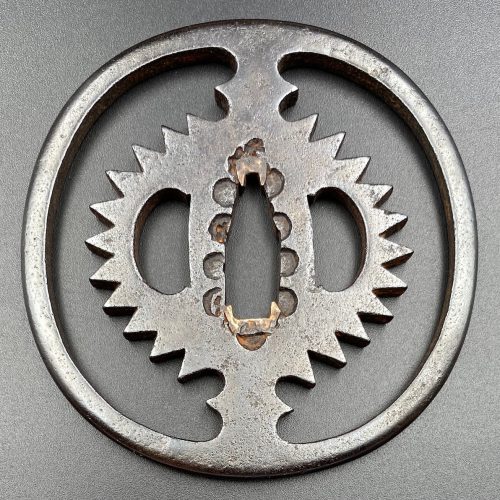 Iron tsuba of round form pierced with the design of slanting rays of light (Christian motif, Jesuit’s IHS symbol) in positive silhouette (ji-sukashi). This design is often called “tokei” [時計], or “clock gear”. Nakaga-ana fitted with copper sekigane. Rounded rim. Unsigned. Higo school. Early Edo period, mid-17th century (1632-1650).
Iron tsuba of round form pierced with the design of slanting rays of light (Christian motif, Jesuit’s IHS symbol) in positive silhouette (ji-sukashi). This design is often called “tokei” [時計], or “clock gear”. Nakaga-ana fitted with copper sekigane. Rounded rim. Unsigned. Higo school. Early Edo period, mid-17th century (1632-1650).Size: 78.3 x 77.0 x 5.3 mm
For information regarding this type of tsuba see the article 'Kirishitan Ikenie Tsuba by Fred Geyer at Kokusai Tosogu Kai; The 2nd International Convention & Exhibition, October 18-23, 2006, pp. 84-91. School and age attribution thanks to Bruce Kirkpatrick. . 
IHS emblem of the Jesuits
-
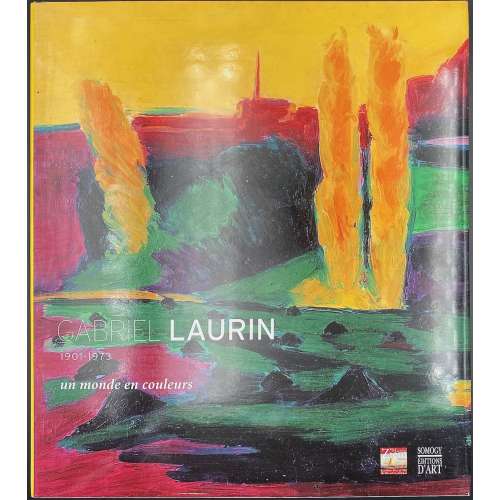 Hardcover volume, 28.5 x 25.5 cm, green lettered boards, pictorial dust jacket, pp.: [1-13] 14-143 [144], ils., inset: double-sheet 29.7 x 21 cm, “Exposition du 4 novembre 2006 au 4 février 2007”. Published on the occasion of the exhibition "Gabriel Laurin d'Aix (1901-1973)" held at the Musée Ziem, Martigues, Nov. 3, 2006 — Feb. 4, 2007. Title-page: GABRIEL LAURIN | un monde en couleurs | 1901-1973 | Sous la direction de Gérard Fabre | Texte de Jeanine Warnod | {publishers devices} || Contributors: Gabriel Laurin (French, 1901 – 1973) Jeanine Warnod (French, b. 1921) Gérard Fabre (French, b. 1963)
Hardcover volume, 28.5 x 25.5 cm, green lettered boards, pictorial dust jacket, pp.: [1-13] 14-143 [144], ils., inset: double-sheet 29.7 x 21 cm, “Exposition du 4 novembre 2006 au 4 février 2007”. Published on the occasion of the exhibition "Gabriel Laurin d'Aix (1901-1973)" held at the Musée Ziem, Martigues, Nov. 3, 2006 — Feb. 4, 2007. Title-page: GABRIEL LAURIN | un monde en couleurs | 1901-1973 | Sous la direction de Gérard Fabre | Texte de Jeanine Warnod | {publishers devices} || Contributors: Gabriel Laurin (French, 1901 – 1973) Jeanine Warnod (French, b. 1921) Gérard Fabre (French, b. 1963) -
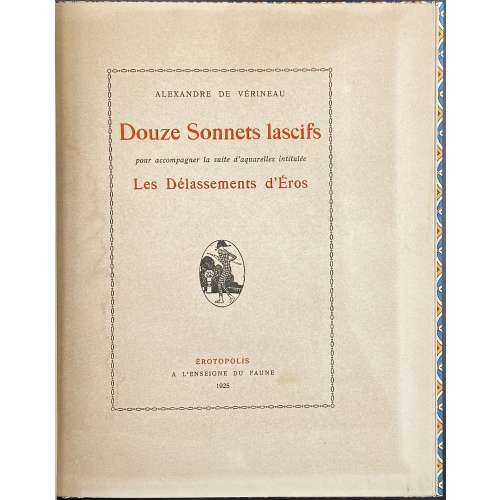 Volume bound by Boichot (signed on front pastedown), 25.3 x 20.2 cm in a 25.9 x 20.3 slipcase, the book and the case uniformly in beige, brown, and blue diaper paper with a navy blue label with gilt lettering to book's spine, top edge gilt, J.-P. Dutel’s bookplate to fep, portfolio cover preserved. Pp.: [1-4] 5-37 [38 blank]; collated 4to, 13 2-54; total 19 leaves (38 pages), plus 12 plates coloured in stencil technique (pochoir), produced after watercolours by Gerda Wegener in c. 1917 on Arches or Whatman laid paper, watermarked. Each illustration bears a small masquerade mask at the bottom as a signature. Text printed on laid paper without a watermark; starting from 2nd gathering, the text printed on recto only; minor traces of water stain to some pages. Title-page (red and black): ALEXANDRE DE VÉRINEAU | Douze Sonnets lascifs | pour accompagner la suite d’aquarelles intitulée | Les Délassements d’Éros | {vignette medallion} | ÉROTOPOLIS | A L’ENSEIGNE DU FAUNE | 1925 || First edition, first printing (incl. plates); clandestine. Catalogue raisonné: Dutel 1356, 1434; Pia 363/4; Noedmann I 310; Fekete 221. Contributors: Louis Perceau (French, 1883 – 1942) – author (see LIB-2633.2021: Guillaume Apollinaire, Fernand Fleuret, Louis Perceau. L'enfer de la Bibliothèque Nationale. — Paris: Mercure de France, 1913). Gerda Wegener (Danish, 1886 – 1940) – artist. Maurice Duflou (French, 1885 – 1951) – publisher. Boichot – bookbinder.
Volume bound by Boichot (signed on front pastedown), 25.3 x 20.2 cm in a 25.9 x 20.3 slipcase, the book and the case uniformly in beige, brown, and blue diaper paper with a navy blue label with gilt lettering to book's spine, top edge gilt, J.-P. Dutel’s bookplate to fep, portfolio cover preserved. Pp.: [1-4] 5-37 [38 blank]; collated 4to, 13 2-54; total 19 leaves (38 pages), plus 12 plates coloured in stencil technique (pochoir), produced after watercolours by Gerda Wegener in c. 1917 on Arches or Whatman laid paper, watermarked. Each illustration bears a small masquerade mask at the bottom as a signature. Text printed on laid paper without a watermark; starting from 2nd gathering, the text printed on recto only; minor traces of water stain to some pages. Title-page (red and black): ALEXANDRE DE VÉRINEAU | Douze Sonnets lascifs | pour accompagner la suite d’aquarelles intitulée | Les Délassements d’Éros | {vignette medallion} | ÉROTOPOLIS | A L’ENSEIGNE DU FAUNE | 1925 || First edition, first printing (incl. plates); clandestine. Catalogue raisonné: Dutel 1356, 1434; Pia 363/4; Noedmann I 310; Fekete 221. Contributors: Louis Perceau (French, 1883 – 1942) – author (see LIB-2633.2021: Guillaume Apollinaire, Fernand Fleuret, Louis Perceau. L'enfer de la Bibliothèque Nationale. — Paris: Mercure de France, 1913). Gerda Wegener (Danish, 1886 – 1940) – artist. Maurice Duflou (French, 1885 – 1951) – publisher. Boichot – bookbinder. -
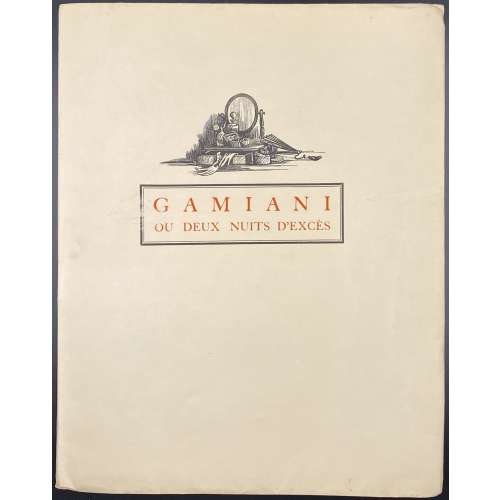 Description: Softcover volume 27 x 21.3 cm in publisher’s French flapped cream wrappers, with a vignette and lettered in red within a black frame to front "GAMIANI | OU DEUX NUITS D'EXCÈS". Printed on unmarked wove paper, outer and lower margins untrimmed. Illustrated with full-page frontispiece, 10 headpieces, and 5 smaller woodcuts (one repeated on the front wrapper and on t.p.) by Pierre Aubert after Jean-Gabriel Daragnès [pseud. Jean de Guethary], some with inlaid tissue guards. Copy enriched with one graphite pencil drawing signed "J. de Guethary", tipped in before h.t. Title-page (red and black): GAMIANI | OU DEUX NUITS D'EXCÈS | PAR A. DE M. | Avec | des vignettes | de | JEAN DE GUETHARY | {VIGNETTE} | — | CHEZ UN BOURGEOIS DE PARIS | Rue du Coq Hardi | 1845 || Pagination: [i-vi] (orig. drawing, h.t. / vignette, t.p./limit.) [vii] viii-xx, [1-3] 4-64 [4]; total 88 pages. Limitation: Edition limited to 110 copies. According to Dutel, 110 copies were printed on Japon ancient, 3 on Japon Impérial, and 3 on Whatman. This copy is № 115. Catalogue raisonné: Dutel (1920-1970): № 1630, p. 183; Pia (Enfer) 527, p. 286. Alfred de Musset (French, 1810 – 1857) – author. Jean-Gabriel Daragnès (French, 1886 – 1950) – artist, publisher. Pierre Aubert (Swiss, 1910 – 1987) – engraver.
Description: Softcover volume 27 x 21.3 cm in publisher’s French flapped cream wrappers, with a vignette and lettered in red within a black frame to front "GAMIANI | OU DEUX NUITS D'EXCÈS". Printed on unmarked wove paper, outer and lower margins untrimmed. Illustrated with full-page frontispiece, 10 headpieces, and 5 smaller woodcuts (one repeated on the front wrapper and on t.p.) by Pierre Aubert after Jean-Gabriel Daragnès [pseud. Jean de Guethary], some with inlaid tissue guards. Copy enriched with one graphite pencil drawing signed "J. de Guethary", tipped in before h.t. Title-page (red and black): GAMIANI | OU DEUX NUITS D'EXCÈS | PAR A. DE M. | Avec | des vignettes | de | JEAN DE GUETHARY | {VIGNETTE} | — | CHEZ UN BOURGEOIS DE PARIS | Rue du Coq Hardi | 1845 || Pagination: [i-vi] (orig. drawing, h.t. / vignette, t.p./limit.) [vii] viii-xx, [1-3] 4-64 [4]; total 88 pages. Limitation: Edition limited to 110 copies. According to Dutel, 110 copies were printed on Japon ancient, 3 on Japon Impérial, and 3 on Whatman. This copy is № 115. Catalogue raisonné: Dutel (1920-1970): № 1630, p. 183; Pia (Enfer) 527, p. 286. Alfred de Musset (French, 1810 – 1857) – author. Jean-Gabriel Daragnès (French, 1886 – 1950) – artist, publisher. Pierre Aubert (Swiss, 1910 – 1987) – engraver. -
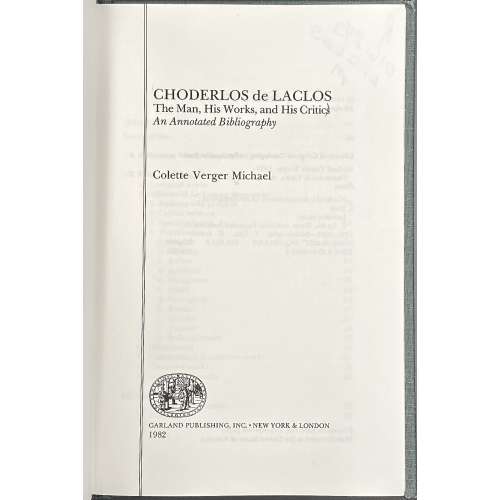 One volume 22.3 x 14.4 cm, green buckram, gilt lettering to spine, Brooklyn public library copy with stamps and sticker; [i-iv] v-xi [xii blank], [1-2] 3-144 [4 blank], total 160 pages, 80 leaves; 620 entries + index. Title-page (vertical double-rule, left indent): CHODERLOS de LACLOS | The Man, His Works, and His Critics | An Annotated Bibliography | Colette Verger Michael | {publisher’s device} | GARLAND PUBLISHING INC. • NEW YORK & LONDON | 1982 || Contributors: Michael, Colette Verger (American, b. 1937) Choderlos de Laclos, Pierre Ambroise François (French, 1741 – 1803) – author. Ref.: WorldCat.
One volume 22.3 x 14.4 cm, green buckram, gilt lettering to spine, Brooklyn public library copy with stamps and sticker; [i-iv] v-xi [xii blank], [1-2] 3-144 [4 blank], total 160 pages, 80 leaves; 620 entries + index. Title-page (vertical double-rule, left indent): CHODERLOS de LACLOS | The Man, His Works, and His Critics | An Annotated Bibliography | Colette Verger Michael | {publisher’s device} | GARLAND PUBLISHING INC. • NEW YORK & LONDON | 1982 || Contributors: Michael, Colette Verger (American, b. 1937) Choderlos de Laclos, Pierre Ambroise François (French, 1741 – 1803) – author. Ref.: WorldCat. -
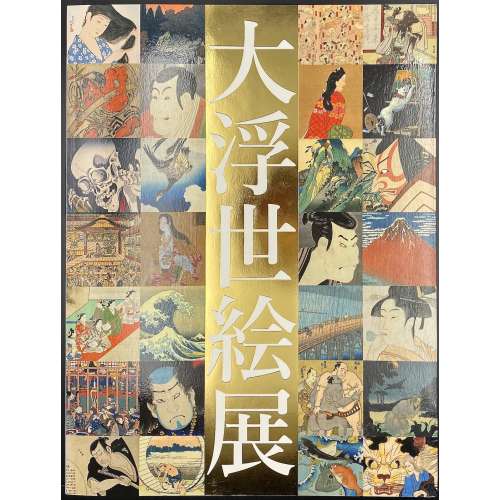 Softcover volume 29.8 x 22.7 cm in publisher’s flapped pictorial wrappers, lettered in Japanese; pp.: [1-4] 5-365 [3], total 184 leaves; pp. 26-267 present 438 illustrations, text in Japanese and English. Reference in this collection: SVJP-0234.2018 – here it is also described as a diptych.
Softcover volume 29.8 x 22.7 cm in publisher’s flapped pictorial wrappers, lettered in Japanese; pp.: [1-4] 5-365 [3], total 184 leaves; pp. 26-267 present 438 illustrations, text in Japanese and English. Reference in this collection: SVJP-0234.2018 – here it is also described as a diptych.
№ 358, p. 226. Bandō Mitsugorō III as Grand arbiter Kiyosumi and Arashi Koroku IV as Koganosuke.
-
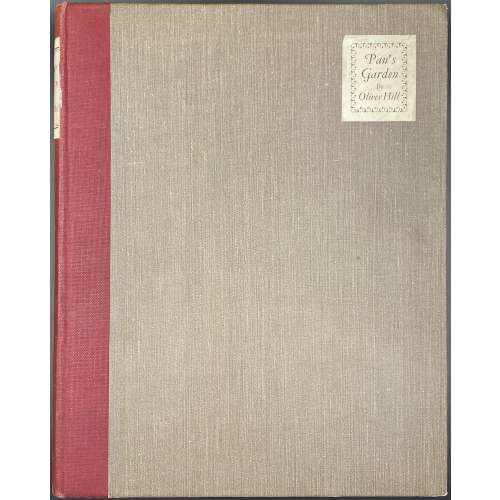 Description: Hardcover photographic pictorial album, 29.2 x 23.1 cm, quarter crimson percaline over grey cloth with lettered paper labels to front cover and spine, grey endpapers; pp. [1-4] 5-109 [3], total 56 leaves, additional spine and cover labels tipped-in. Oliver Hill (British, 1887 – 1968).
Description: Hardcover photographic pictorial album, 29.2 x 23.1 cm, quarter crimson percaline over grey cloth with lettered paper labels to front cover and spine, grey endpapers; pp. [1-4] 5-109 [3], total 56 leaves, additional spine and cover labels tipped-in. Oliver Hill (British, 1887 – 1968). -
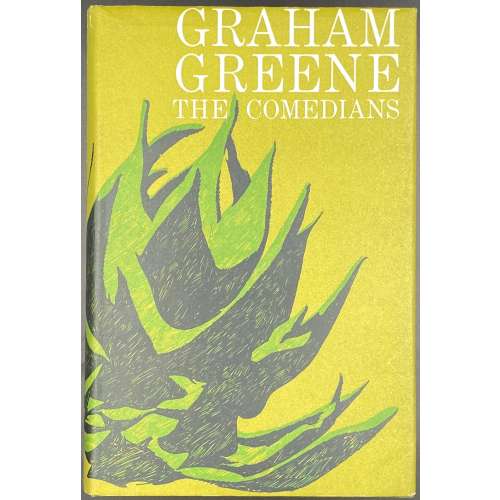 DJ: Graham Greene | THE COMEDIANS || Title page: THE COMEDIANS | Graham Greene | {four lines citation from Thomas Hardy} | {publisher’s device} | THE BODLEY HEAD| LONDON || Edition: 1st edition, 1st printing. Binding: bound in green cloth, 20.5 x 13.5 cm, with gilt lettering to spine, in green pictorial dust jacket with white lettering, price clipped; gift autograph to fep: “To. | Richard | From: gig | Xmas 1964.” (sic., the book was published in 1966!) Pagination: [1-4] 5-313 [314 blank] [6] blanks (total 320 pages). Collation: 16mo; [A]4 B-K16 L12 (total 160 leaves).
DJ: Graham Greene | THE COMEDIANS || Title page: THE COMEDIANS | Graham Greene | {four lines citation from Thomas Hardy} | {publisher’s device} | THE BODLEY HEAD| LONDON || Edition: 1st edition, 1st printing. Binding: bound in green cloth, 20.5 x 13.5 cm, with gilt lettering to spine, in green pictorial dust jacket with white lettering, price clipped; gift autograph to fep: “To. | Richard | From: gig | Xmas 1964.” (sic., the book was published in 1966!) Pagination: [1-4] 5-313 [314 blank] [6] blanks (total 320 pages). Collation: 16mo; [A]4 B-K16 L12 (total 160 leaves). -
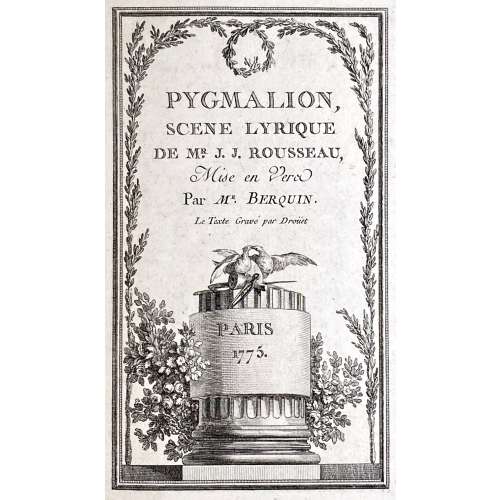 One volume, 22.8 x 15.5 cm, bound in full mottled calf, gilt floral frames to covers, raised bands and gilt fleurons to spine, printed on laid paper. Regarding Pygmalion, scène lyrique see: Wekipedia. Collation: Free endpaper and two blank flyleaves, [2] engraved title, [2] préface, 1-18 (Pygmalion), [2] f.t.p., [1] 2-8 (Idylle), two blank flyleaves and free endpaper; 20 leaves total, adorned with 7 headpieces and 1 tailpiece engraved by Nicolas de Launay, Nicolas Ponce and Charles Etienne Gaucher after Jean Michel Moreau the Younger and Clément Pierre Marillier; text engraved by Droüet. Title-page: PYGMALION, | SCENE LYRIQUE | DE MR. J. J. ROUSSEAU, | Mise en Vers | par MR. Berquin. | Le Text Gravé par Droüet | PARIS | 1775. || (on a column under two kissing doves and sculptor’s tools). Faux t.p.: IDYLLE | Par MR. Berquin. | — | Eructavit cor meum verbum bonum ; | dico ego opera mea regi. | Psalm. 44. | — || (in rules). Catalogue raisonné: Cohen-DeRicci 141 ; Lewine 55. Ref.: MFA (Boston); MET (NY); Yale University Library. Contributors: Artists: Jean-Michel Moreau le Jeune (French, 1741–1814) Clément Pierre Marillier (French, 1740–1808) Engravers: Nicolas Delaunay (French, 1739–1792) Charles-Étienne Gaucher (French, 1741–1804) Nicholas Ponce (French, 1746–1831) Droüet (French, 18th century) Authors: Arnaud Berquin (French, 1747–1791) Jean-Jacques Rousseau (French, 1712–1778)
One volume, 22.8 x 15.5 cm, bound in full mottled calf, gilt floral frames to covers, raised bands and gilt fleurons to spine, printed on laid paper. Regarding Pygmalion, scène lyrique see: Wekipedia. Collation: Free endpaper and two blank flyleaves, [2] engraved title, [2] préface, 1-18 (Pygmalion), [2] f.t.p., [1] 2-8 (Idylle), two blank flyleaves and free endpaper; 20 leaves total, adorned with 7 headpieces and 1 tailpiece engraved by Nicolas de Launay, Nicolas Ponce and Charles Etienne Gaucher after Jean Michel Moreau the Younger and Clément Pierre Marillier; text engraved by Droüet. Title-page: PYGMALION, | SCENE LYRIQUE | DE MR. J. J. ROUSSEAU, | Mise en Vers | par MR. Berquin. | Le Text Gravé par Droüet | PARIS | 1775. || (on a column under two kissing doves and sculptor’s tools). Faux t.p.: IDYLLE | Par MR. Berquin. | — | Eructavit cor meum verbum bonum ; | dico ego opera mea regi. | Psalm. 44. | — || (in rules). Catalogue raisonné: Cohen-DeRicci 141 ; Lewine 55. Ref.: MFA (Boston); MET (NY); Yale University Library. Contributors: Artists: Jean-Michel Moreau le Jeune (French, 1741–1814) Clément Pierre Marillier (French, 1740–1808) Engravers: Nicolas Delaunay (French, 1739–1792) Charles-Étienne Gaucher (French, 1741–1804) Nicholas Ponce (French, 1746–1831) Droüet (French, 18th century) Authors: Arnaud Berquin (French, 1747–1791) Jean-Jacques Rousseau (French, 1712–1778) -
 Hardcover, 28 x 19 cm, black cloth with gilt lettering to spine, red pictorial dust jacket; pp.: [i-vii] viii-x [2] [1] 2-540 [8], total 560 pages, profusely illustrated. Title-page: The private library | ~ | Being a More or Less Compendious Disquisition | on | The History of the Architecture and | Furnishing of the Domestic Bookroom | ☙ ❧ | Reid Byers | {publisher’s device} | New Castle, Delaware | 2021 || ISBN: 9781584563884 Author: Reid Byers (American).
Hardcover, 28 x 19 cm, black cloth with gilt lettering to spine, red pictorial dust jacket; pp.: [i-vii] viii-x [2] [1] 2-540 [8], total 560 pages, profusely illustrated. Title-page: The private library | ~ | Being a More or Less Compendious Disquisition | on | The History of the Architecture and | Furnishing of the Domestic Bookroom | ☙ ❧ | Reid Byers | {publisher’s device} | New Castle, Delaware | 2021 || ISBN: 9781584563884 Author: Reid Byers (American). -
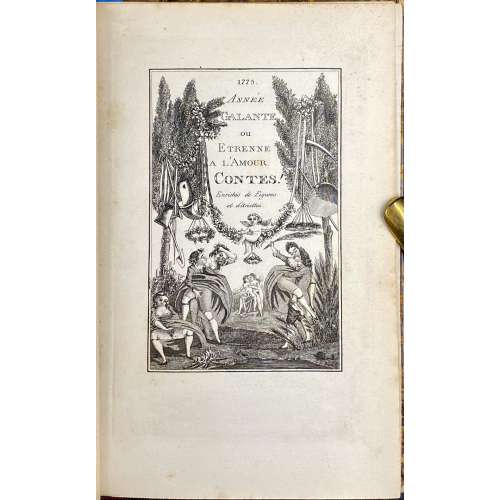 Single volume, 20 x 13 cm, quarter brown morocco over marbled boards tooled in gilt, spine with raised bands, gilt in compartments, and gilt lettering, marbled endpapers, printed on wove paper on recto with verso blank, collated 1-48; total 32 leaves, 11 torn off, 47,8 blanks, ; uneven pagination [1] 2-41 [4 blanks], plus engraved title-page and 12 engraved half-page plates with text, uncoloured, by Louis Jaugey (unsigned), one for each month. Title-page (engraved): vignette with lettering "1775. ANNÉE | GALANTE | OU | ETRENNE | A L'AMOUR | CONTES! | Enrichis de Figures | et d'Ariettes. ||" Catalogue raisonné: Dutel I: A-82. Catalogue Poulet-Malassis & ses amis description: № 68. [Auteur inconnu]. Année galante ou Etrenne à l’amour. Contes, enrichis de Figures et d’Ariees. [Vital Puissant, Bruxelles, 1876 ?] 1775. In-8, 3 .n.ch., 29 . imprimés au recto, chirés de 2 à 41, demi-chagrin brun, dos à nerfs orné, let doré sur les mors, tête et tranches jaspées (reliure ancienne). Illustrée de 13 planches dont l’une en frontispice par Louis Jaugey. Les figures sont à mi-page, une pour chaque mois. Contributors: Louis Jaugey (French, fl. 1871 – 1876) – artist. Vital Puissant (Belgian, 1835 – 1878) – publisher.
Single volume, 20 x 13 cm, quarter brown morocco over marbled boards tooled in gilt, spine with raised bands, gilt in compartments, and gilt lettering, marbled endpapers, printed on wove paper on recto with verso blank, collated 1-48; total 32 leaves, 11 torn off, 47,8 blanks, ; uneven pagination [1] 2-41 [4 blanks], plus engraved title-page and 12 engraved half-page plates with text, uncoloured, by Louis Jaugey (unsigned), one for each month. Title-page (engraved): vignette with lettering "1775. ANNÉE | GALANTE | OU | ETRENNE | A L'AMOUR | CONTES! | Enrichis de Figures | et d'Ariettes. ||" Catalogue raisonné: Dutel I: A-82. Catalogue Poulet-Malassis & ses amis description: № 68. [Auteur inconnu]. Année galante ou Etrenne à l’amour. Contes, enrichis de Figures et d’Ariees. [Vital Puissant, Bruxelles, 1876 ?] 1775. In-8, 3 .n.ch., 29 . imprimés au recto, chirés de 2 à 41, demi-chagrin brun, dos à nerfs orné, let doré sur les mors, tête et tranches jaspées (reliure ancienne). Illustrée de 13 planches dont l’une en frontispice par Louis Jaugey. Les figures sont à mi-page, une pour chaque mois. Contributors: Louis Jaugey (French, fl. 1871 – 1876) – artist. Vital Puissant (Belgian, 1835 – 1878) – publisher.


